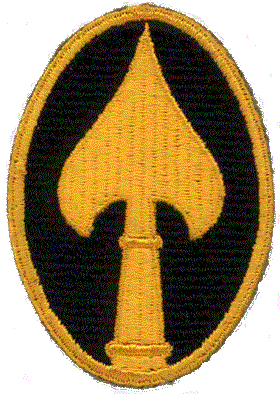Poison Cornflakes for Breakfast
by SGM Herbert A. Friedman (Ret.)
NOTE: this article has a Table of Contents at the end
This article is reproduced on the MPHS website with the permission and assistance of its author, Herbert A. Friedman.
Ownership of the article is his alone.
The original article is located on "psywarrior.com"
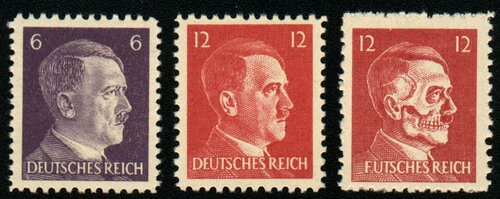
Modified versions of this article were first published in the Society of Philatelic Americans Journal, Volume 34, No. 6, February 1972, and the German Postal Specialist, Volume 38, No. 2, February 1987. In addition, because the operation was both clandestine and involved postage stamps and postcards, the propaganda product is very collectable and has been written about in a number of WWII books and articles in the philatelic press. For instance, some of the books that mention the OSS propaganda campaigns are Anthony Cave Brown’s The Secret War Report of the OSS; R. Harris Smith’s OSS – the Secret History of America’s First Central Intelligence Agency; Neal H. Peterson’s From Hitler’s Doorstep – the Wartime Intelligence reports of Allen Dulles 1942-1945 and Kermit Roosevelt’s Top Secret – The Overseas Targets – War Report of the OSS. Of course, there were many more. I just read off the first few titles in my bookcase.
In 2009, photographs from this article were featured in the Eugene Liptak booklet: Office of Strategic Services 1942-45, Osprey publishing, Oxford, UK, 2009. In early 2011, I was asked by the PBS television show History Detectives to act as a subject matter expert in the production of an “interstitial” on Operations Cornflakes. The segment was aired on PBS 28 June 2011. On 7 March 2012, the British Daily Mail used this article as the basis for a story entitled “Operation Cornflakes: How the Allies went postal in the secret propaganda war against the Nazis.” In December 2012, the magazine Nordisk Filateli used this article for the basis of a 7-page article by Orn Grahm entitled “Operation Cornflakes.” In 2013, researcher Lee Richards told me that in the U.S. National Archives he found a folder on Operation Cornflakes in the OSS records. A surprising addition to that WWII folder was one of my early articles on philatelic propaganda “Allied Forgeries of the Postage Stamps of Nazi Germany,” The American Philatelist, February, 1971. Apparently, the Archives collects and adds my articles on espionage and propaganda to their files. On 30 January 2014, The German news magazine Spiegel Online used this article for an illustrated story they published entitled: “Operation Cornflakes: Secret Intelligence Operation in WWII.” In December 2014, the National Archives requested the entire article to be added to their WWII Cornflakes file prepared by the Office of Strategic Services and preserved by the CIA. In 2015, the author was interviewed and items from this article were used by Nimitz High School in Houston, Texas, to build a “Leadership and Legacy in History” website for a National History Competition sponsored by the History Channel. In 2016, parts of this story were also used by Bob Baltzell in a two-part article entitled “The Clandestine Stamps of President Franklin D. Roosevelt” in the American Stamp Dealer & Collector Magazine. In January 2016, the National Geographic Magazine requested permission to use images from this article for a book entitled Secret War. Military History Magazine requested permission to use images from this article for a March 2016 story about the OSS in WWII. A March 2016 request was received and approved to use data from this article in an article in the Austrian philatelic magazine Die Briefmarke. In 2016, items from this article were used by Seaman High School in Topeka, Kansas, to build an “Exploration, Encounter and Exchange in History” website for a National History Competition sponsored by the History Channel. In May 2017 author Phil Froom requested the use of images and data for an article to be published in British Militaria magazine. In 2021, the website Stories behind the Stamps depicted the Hitler head counterfeits we show below in their March 16 report number 15 titled “Operation Cornflakes.” In June 2021, this article was used as a reference source in the Dutch Ministry of Defense military website Defense Newspaper in an article by Evert Brouwer titled “Operation Cornflakes.” In June 2019, A Finnish author asked to use this article as a reference source for an article titled “American Hitler Forgeries: the Case of Operation Cornflakes,” in the Fakes, Forgeries and Experts Journal and Journal of the Philatelic Federation of Finland.
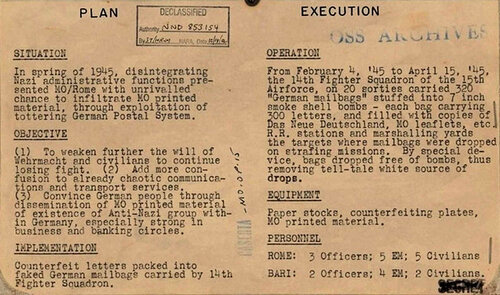
Office of Strategic Services Document mentioning Operation Cornflakes
This document is poorly written with bad grammar and several misspelled words. Even when the words are correct they are often not those that would have been used by a Native American. When I first saw it I thought it was probably a forgery. The date of declassification is difficult to read but seems to be 12/19/02. I did note that even with all the errors the data was absolutely correct. Trying to determine if this document was genuine or fake, we searched the OSS archives, and since it is found in the archives of the OSS it must be genuine.
This document was found in Record Group 226: Records of the Office of Strategic Services, 1919 - 2002 Series: Field Station Files, 1943 - 1945 File Unit: Folder 842: CASERTA-MO-OP-15: Production MTO: Cornflakes Item: Cornflakes Project.
Note that the card is coded op.15, and the Cornflakes booklet from the OSS Archives directly below is op.14. That seems to tie this all together.
General Mark Clark’s 5th U.S, Army captured Rome on 4 June 1944. General Donovan attached an Office of Strategic Services unit to Clark’s troops shortly afterwards. This was the 2677th OSS Detachment. The Regiment was activated July 1944. Headquarters of the 2677th Regiment OSS (Provisional) was first established at the former Fifth Army Detachment base in the palace at San Leucio, near Caserta, with complete responsibility for all OSS operations from the Mediterranean into France, Italy, the Balkans, and the Middle East. It was authorized 476 officers and 1,498 enlisted men. Under the new 2677th Regiment, activities were channeled into three main efforts - to southern France, up the Italian mainland, and toward the Balkans. Four OSS Companies, A, B, C and D, were established. For better communication with OSS Bern, a Swiss Desk was established at Regiment headquarters in July 1944. At the time of the Cornflakes operation we will discuss, the Unit was stationed in Rome.
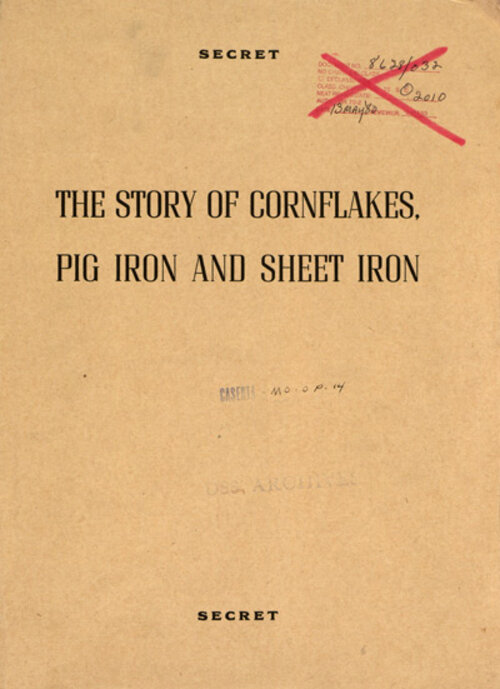
The Story of Cornflakes, Pig Iron and Sheet Iron
Operation Cornflakes is one of the best known Office of Strategic Services (OSS) secret “black” operations of WWII. The reason it is so well known is that the OSS Rome Detachment prepared publicity booklets to be given to visiting politicians and members of the Congressional Oversight Committee. They realized that these people held the OSS purse-strings, and they wanted to keep them happy and up-to-date on current projects. It is not known exactly how many such booklets, entitled The Story of Cornflakes, Pig Iron and Sheet Iron exist, but I have seen numbers as high as 20 to 30. We must point out here that there are two different kinds of Cornflakes publications. One is a thin paper-back publicity booklet that explains the operations and contains photographs and souvenirs. The other is a large hard-cover scrapbook that contains about 400 OSS specimens. They are very different and obviously the scrapbook is worth far more than the publicity booklet. After the war, a few such booklets were found in the attic of the home where OSS members were housed. Shortly after the war some were sold for $250. Years later, in 1984 one of the scrapbooks was offered at auction estimated at $5000. The description was:
The original complete sample book displaying extensive anti-Hitler and anti-Fascist literature, newspapers, propaganda, leaflets, etc. as printed and compiled by one of the directors of the whole operation, Robert Allen. Well over 300 items, the documents are mostly in German but also some in Italian and Russian. Included is a large production report, photographs of the presses and a complete sheet of 50 of the Hitler Death Mask propaganda label as manufactured by the Rome printing presses.
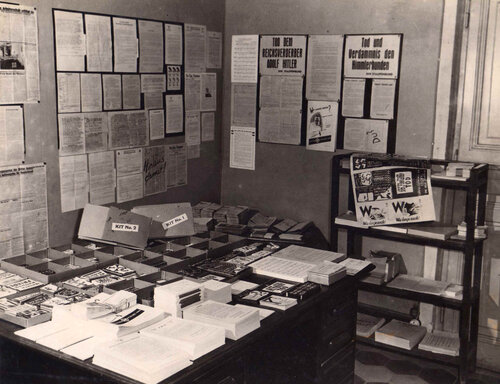
The OSS Rome Printing Plant
This photograph gives an example of all the various types of PSYOP products produced in the OSS printing plant. We see posters, letters, leaflets, and at the lower left, gummed propaganda stickers to be placed on walls and windows. In the dead center of the photo, the third item from the top is the leaflet “Ten Commandments for Austrians” which we depict and translate toward the end of this article.
My entry on First Lieutenant Robert Allen states that he was an Army intelligence officer who entered the service on 29 December 1943 at the age of 25 and arrived in Rome on 3 August 1944. His separation papers state:
He was assigned to the Office of Strategic services and went to Italy where he was the Executive Officer of an OSS branch collecting and evaluating intelligence on foreign policies. He also supervised the operation of a print shop. In June 1945 he became Executive Officer of a Field Photographic branch of OSS supervising taking still and motion pictures and supervising work on aerial photography.
He saved specimens the OSS Rome propaganda in several scrapbooks to preserve documentation for congressional leaders who would determine support for MO activities. Early data implied that at least four of Allen’s scrapbooks survived the war. In addition, Army Corporal Egidio Clementi, the chief printer, collected two specimen copies of all printed MO Rome propaganda. In the 1960s he donated one set to Guilio Polotti, the president of the Anna Kuliscioff Foundation in Milan, Italy.
Another such “Allen scrapbook” was bought privately about the same time for $3700. The seller of the book claimed that Robert Allen had prepared six such large scrapbooks, with heavy covers, about 1 inch thick, and fastened with three brass screw-and-socket connectors. The pages were 15 x 22-inches. Some of the items were marked “attic” so they might have been from the cache found in the Rome attic. This book contained 64 pages, with about 290 major documents and 190 small stickers, with minor duplication, making a total of about 480 pieces. Among the more interesting items were 14 of the OSS postcards; 6 feldpost letter sheets; 1 feldpost wrapper; 1 “Sign of Life” postcard; 1 complete sheet of the Futsches Reich skull stamp parody; 2 sex leaflets; and 1 sex booklet. There were several copies of Das Neue Deutschland (small size), and many other non-philatelic documents.
A third Cornflakes scrapbook was offered in Switzerland about the same time estimated at $6000. The description of this book includes:
…It is stated that only three copies of these records were made, one of which is in the Library of Congress…In this volume there are 24 photographs of various stages of the Austrian operation…205 items for Germany including 4 feldpost letter cards, 4 music sheets, 140 notices to the German civilians and armed forces (leaflets, letters and gummed stickers), 12 copies of Das Neue Deutschland…
In addition, there were 48 items for Austria, 8 items for Czechoslovakia, 1 item for Hungary, and 46 items for Italy.
A fourth scrapbook, marked “Attic,” was auctioned in 1971. Apparently the owner had both the booklet and the scrapbook. He told me:
There are two books. One printed in which photographs of the various stages of the operation were included and which had the printed history of the event. The bound volume contains certain exhibits which have been mounted on album pages for display. They were found in the attic but the apartment has been used by American officials since the occupation of Rome and it would appear that one of the predecessors left these two volumes together with a third volume in the attic. The third volume is a German order of battle printed in English and kept up to date with pencil notes.
We have no knowledge of what the book or books sold for.
The British auction house Robson Lowe told me in 1985:
The officer in charge of the Office of Strategic Services came to see me and brought some duplicate material. He told me that four of these scrapbooks had been made, one of which was in the Library of Congress.
There may have been a fifth scrapbook. We are not sure, but we know that Georges Meyer, former Director of Services for the French War Ministry of Press and Information apparently had a collection that he was given by the French forger Schuhl. Meyer’s collection was deposited in the Service Historique de l'Armée at Castle Vincennes. The last I heard, the collection was unaccounted for, so it may have been sold to a private party.
A Sixth scrapbook was owned by the German propaganda collector Josef Beyer. After his death his collection of over 10,000 leaflets disappeared, but later we found that the remainder of his scrapbook and leaflets were purchased by a German dealer Antiquariat Frank Albrecht.
Each of the soft cover Cornflakes booklets and scrapbooks was a little different. The booklets were prepared as needed and filled with the various propaganda stamps, postcards, letter sheets, leaflets and stickers that were available in the OSS printing shop. In addition, many contained photographs of the operation.
The term “cornflakes” is a special term and we must be careful how we use it. Because almost 400 items are known in the various Cornflakes scrapbooks, all these items have been called and labeled as Cornflakes products. In fact, many of the items were prepared for other campaigns like Operation Sauerkraut or dropped from aircraft along with weapons and ammunition to partisans behind German lines. As you will see in this article, there are numerous items identified as Cornflakes products, but in fact, since the operation was a very limited one involved with dropping mailbags over destroyed German trains, few of the items were really part of Operations Cornflakes. For the purposes of this article, anything found in one of the booklets or scrapbooks will be considered a Cornflakes product.
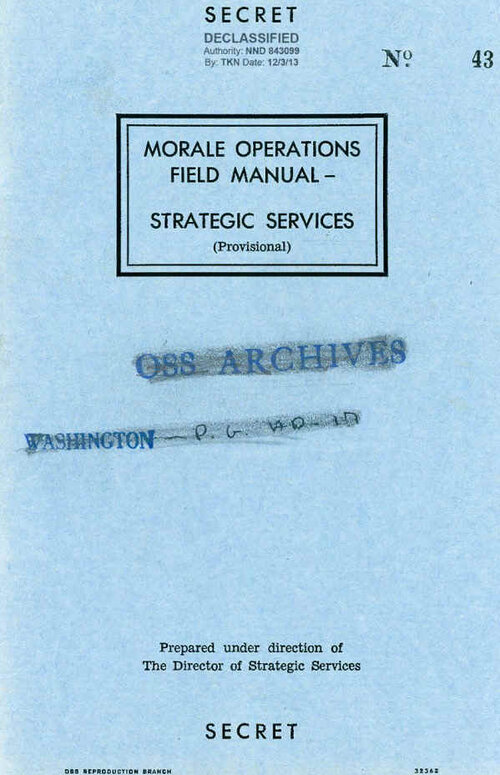
Morale Operations Field Manual - Special Services
What was the purpose of all these leaflets and letters that appeared to come from inside Germany? In 1943, the OSS published a classified secret Morale Operations Field Manual - Special Services. It explained the philosophy, concepts, operations and definitions needed by agents in the field.
Forgeries includes the writing of poison-pen letters, forging of misleading intelligence documents, falsification of enemy documents and periodicals, and the printing of false orders to the enemy, regulations, and proclamations. Leaflets, pamphlets, and graphics are used for subversive deception within enemy and enemy-occupied countries and not identifiable with any official or semi-official United Nations agency.
FALSE LEAFLETS, PAMPHLETS, & GRAPHICS: This type of implement refers to printed, mimeographed or written literature and graphics distributed secretly in enemy territory and under concealed sponsorship. This includes chain and, other anonymous letters, chalking symbols and messages on walls. The false pamphlet sponsored by a belligerent nation attempts to convey the impression that it is a bona fide message from the people's own fellow country-men who are sharing the same risks as the rest of the population and have similar aspirations, aims, and goals.
An appeal to nationalistic attitudes is more effective when made by the nationals of the group than when made by another nation which has its own nationalistic axe to grind. Likewise, incitement to action or revolt coming from a representative of an aggrieved group is more effective than such incitement coming from an "outsider." Whenever an attempt is made to assure potential sympathizers that they would not be alone in resistance activities, such assurance comes better from a group which is presumably carrying on the same activities under the same conditions and taking the same risks.
USES OF LEAFLETS: In general, the leaflet can be used for dissemination of "forbidden" news, spreading of rumors, exposing nefarious activities of enemy officials and collaborationists, giving reassurances to potential sympathizers, instructing in sabotage, inciting to subversive activities, and preparing the populace for cooperation with invading troops. The false leaflet can be capitalized upon by propaganda agencies in popularizing a passive resistance campaign (such as the "V" campaign or the "1918" campaign). It may be desirable to have the campaign "planted" via false pamphlets. This "spontaneous" activity can then be picked up by the authorized propaganda agencies. (2) The false pamphlet can be effectively used to make the enemy uneasy about the loyalty of the people in the territory. The very existence of clandestine pamphlets is "evidence" of underground activity.
The concept of Morale Operations is mentioned in Ann Todd’s book: OSS Operation Black Mail – One woman’s covert War against the Imperial Japanese Army, Naval Institute Press, Annapolis, MD, 2017. The author tells us about the people involved and the expectations of their propaganda:
They were not elite soldiers poached from the regular armed forces or movie stars who flocked to OSS in search of adventure and the chance to make a difference. MO brought in a wave of artists, journalists, and people who were deeply familiar with the languages and cultures of far-flung parts of the globe. Creative types. Professionals, many too old to enlist but eager to join the war, preferably “over there.” They would learn the art of black propaganda. Their job was to bend all their creative energies to destroying the morale of the Japanese soldier, as well as his family back home, infecting both with defeatism and a burning desire to end the war. The goal was to deceive and trick the enemy into surrendering, thereby saving many lives on both sides.
MO had its own unique requirements, first and foremost a willingness to toil at something for which there would be no rewards, not even intangible ones. The battle to demoralize the enemy never concluded with clear victory or defeat, and rarely was there any indication an operation had achieved a desired result. Additionally, the practice of deception was viewed askance by everyone else involved in the war effort. MO was unsavory in the eyes of the military, government, and Allies, but none of this mattered because it was valued by one person: William J. Donovan.
A brief history of Morale Operations from the War Report of the OSS:
On 27 October 1943, MO was charged with the "execution of all forms of morale subversion by divers means including False rumors, 'freedom stations', false leaflets and false documents, the organization and support of fifth column activities by grants, trained personnel and supplies and the use of agents, all for the purpose of creating confusion, division and undermining the morale of the enemy. The Branch expanded rapidly in the last half of 1943. In May MO/ Washington had a staff of twelve. By August it had 75, and by January 1944 it had 150. It was decreed that the Office of War Information would be responsible for leaflets dropped by aircraft and traceable to their actual source. However, leaflets dropped in containers to a reception committee for dissemination and purporting to come from a subversive organization in enemy or enemy occupied territory would be within the province of MO. About radio, OSS agreed not to install or operate "black" stations outside enemy-controlled territory without the Office of War Information's concurrence. OWI, in turn, agreed not to operate agents or installations inside enemy territory. Provision was also made for close working relationships in the field.
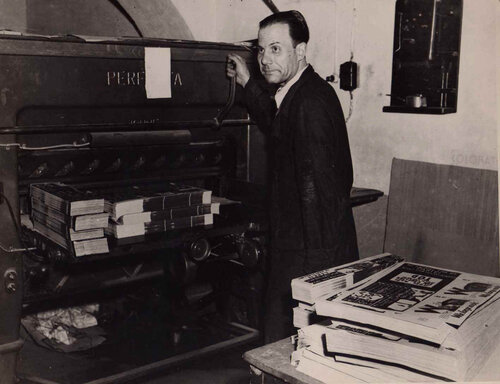
A Cornflakes printer stands by stacks of his propaganda products. We can identify leaflets of the series of sixteen entitled Wie lange noch? (“How much longer?”) at the far right of the table. Besides the leaflets, posters and gummed labels using a large 'W' as a symbol were placed on German vehicles, on walls, on doors and windows, in books and other appropriate places, by agents operating behind enemy lines
Before we discuss Operation Cornflakes perhaps we should mention the two operations that pre-dated Cornflakes, Operation Pig Iron and Sheet Iron. These two operations were Morale Operations’ (MO) initial attempts at air-dropped propaganda. Pig Iron was the dropping of miniature copies of Das Neue Deutschland (The New Germany) into the German homeland. MO photographically reduced the propaganda newspaper in size to 10 x 6-inches and proceeded to drop 10 million copies over Germany. The newspapers were packed into a special cylindrical device allowing them to slide into propaganda bombs. The leaflets were then transported to Foggia where they were packed into bombs. Once Cornflakes came online these miniature papers were placed into envelopes. They were also packed into food tins, cigarette packages, and even small cylindrical containers which could be floated by river behind German lines.
Das Neue Deutschland was a fictitious, clandestine peace party, allegedly organized in Germany in April 1944 whose goal was an anti-Nazi revolution and the re-creation of a liberal democratic Germany. Membership applications were dropped to enemy soldiers and civilians throughout Europe. Its official organ, the newspaper Das Neue Deutschland, had an initial average run of 75,000 copies and later increased to 1 million per issue.
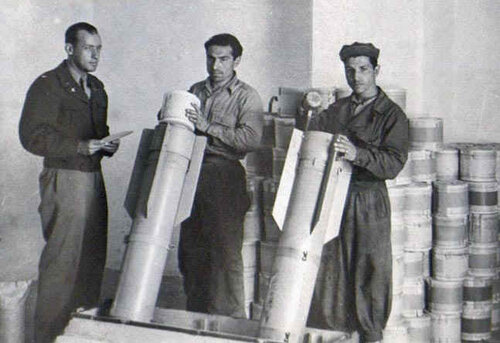
Members of the Cornflakes group load miniature copies of Das Neue Deutschland newspaper into leaflet bombs. Notice the leaflet rolls in the background. The Second Lieutenant at the far left with clipboard is Marcel Robich. He later received a cable from Eugene Warner saying:
Reich Postmaster General broadcast order that civilian mail should be delivered at any cost and by any means or transport available. This means that CORNFLAKES can be dropped on trucks or wagons or even open roads. Please consult Airforce.
Sheet Iron was a similar operation. Instead of the German newspaper, this was the delivery of the Italian-language newspaper La Riscossa Italiana. Originally they were printed in Grenoble, France and infiltrated back into Italy by skiers. This newspaper was very special. The articles were written by partisans in Italy, then smuggled to MO where the newspapers were printed, reduced to one-fourth size by photography in the MO print shop, and then disseminated back behind the Italian lines. Later, 100,000 of the newspapers were printed in Rome and dropped by an A-20 medium bomber over Turin and other Northern Italian cities on Hitler’s birthday, 20 April 1945.
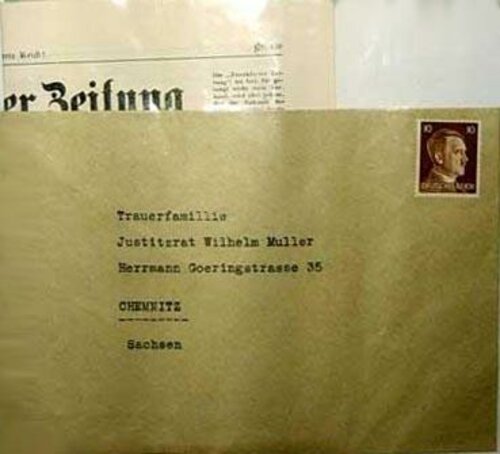
An OSS envelope with genuine stamp and copy of the Frankfurter Zeitung
As mentioned in the Donovan letter below, here is an envelope and copy of the OSS newspaper Frankfurter Zeitung ready to be mailed into Germany.
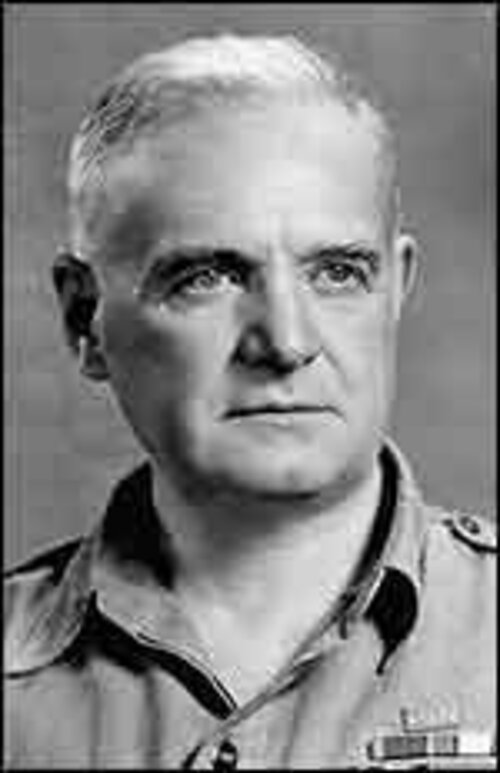
William H. (Wild Bill) Donovan
President Franklin D. Roosevelt was a stamp collector and his political friends knew that. Wild Bill Donovan sent him some of the propaganda stamps that were being printed in Switzerland in early October 1944. A “thank you” note from the President states:
October 5, 1944
Dear Bill,
Ever so many thanks for the Himmler and Hitler stamps. I had heard that there was such a stamp as the Himmler one and it will be an interesting addition to my collection.
My best to you,
Very sincerely yours,
“F.D.R”
What is interesting is that the Himmler parody was produced by Armin Hull for the British Political Warfare Executive starting in December 1942. I wonder if Donovan took credit for this stamp, or did he tell the President that it was made by our allies.
Shortly after his death, President Franklin D. Roosevelt's stamp collection was sold at auction. One of the documents found in this accumulation was a letter to the President from William H. (Wild Bill) Donovan, Director of the Office of Strategic Services (OSS). This letter indicated that the United States government had counterfeited German postage stamps and other documents:
October 24, 1944 Memorandum for the President:
I am herewith enclosing a copy of the FRANKFURTER ZEITUNG, together with copies of a Hitler stamp that I thought you would like to have for your collection.
You may be interested to know that the Hitler stamp was printed in Switzerland by the O.W.I. (Office of War Information) representatives and is one of the many different types of propaganda material that has been secretly printed and introduced into Germany by clandestine means since November of 1942.
Every fortnight approximately 500 to 1200 copies of the Frankfurter Zeitung are likewise sent into Germany where they are mailed to individuals whose addresses appear in the death notices of soldiers who are reported to have died for the fatherland.
(Signed) W.H. Donovan, Director
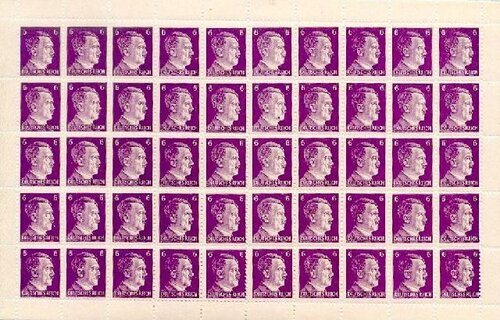
6-PFENNIG FORGERY SHEET
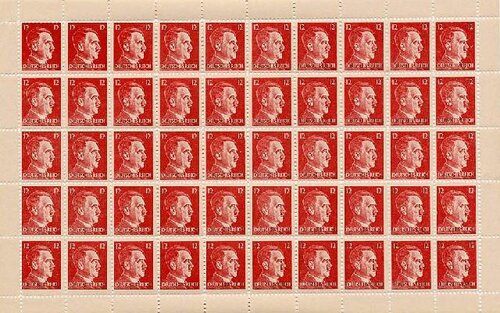
THE 12 PFENNIG FORGERY SHEET
The forgeries are of the 6 and 12 pfennig Hitler head stamps of 1941-1944. Several printings exist with minor differences. The stamps were printed at various times in both Rome and Bern, on different paper, with different perforations, with slight changes in color and the texture of the gum. The forgeries can be immediately recognized by their perforations, anywhere from 11 up to 13. The genuine stamps are perforated 14. The exact number of forged stamps printed by the OSS is unknown, but one official document mentions the production of "726,550 facsimile German Postal Stamps."
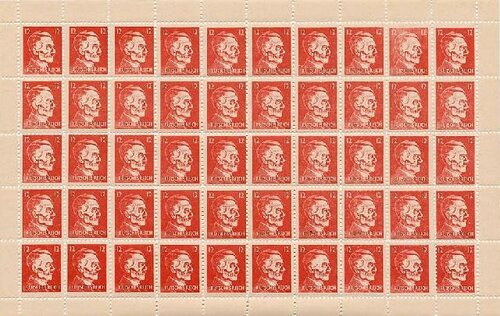
THE HITLER SKULL FORGERY SHEET
In addition, a 12-pfennig parody was altered to show Hitler's head as a skull. This stamp is normally identified as "the Hitler skull stamp" or "the Hitler deaths-head stamp." The text at the bottom of the stamp was altered from DEUTSCHES REICH to FUTSCHES REICH ("LOST EMPIRE"). The OSS printed 1,138,500 of these parody postal stamps and shipped them to their agents al over Europe. The skull stamps were sometimes placed inside envelopes and mailed into Germany. The official OSS file number of the Hitler skull parodies, sometimes found stamped on an archived sheet is 307.
The forgeries were printed in sheets of 50 (five down, ten across). Because of the perforation difference, there is no need to provide a detailed description of the minor variations used to identify the frauds. The major campaign involving these forged stamps was code-named "Operation Cornflakes." This name was the natural result of the aim of the campaign, to place American propaganda on the German breakfast table each morning.
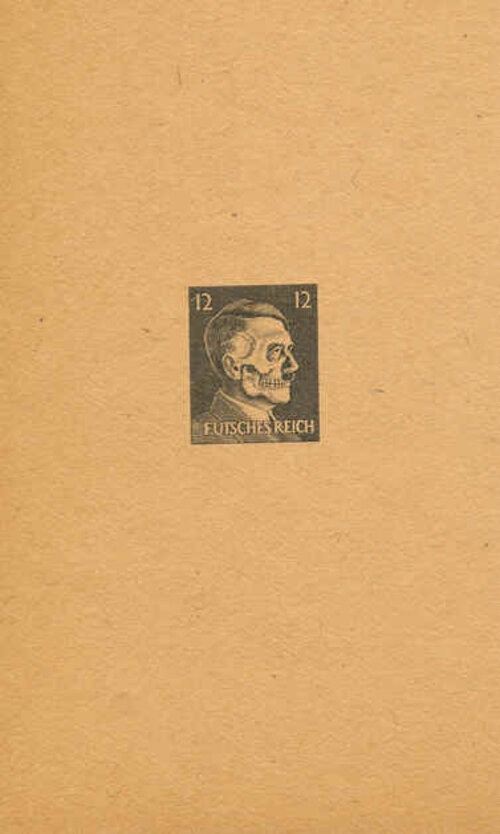
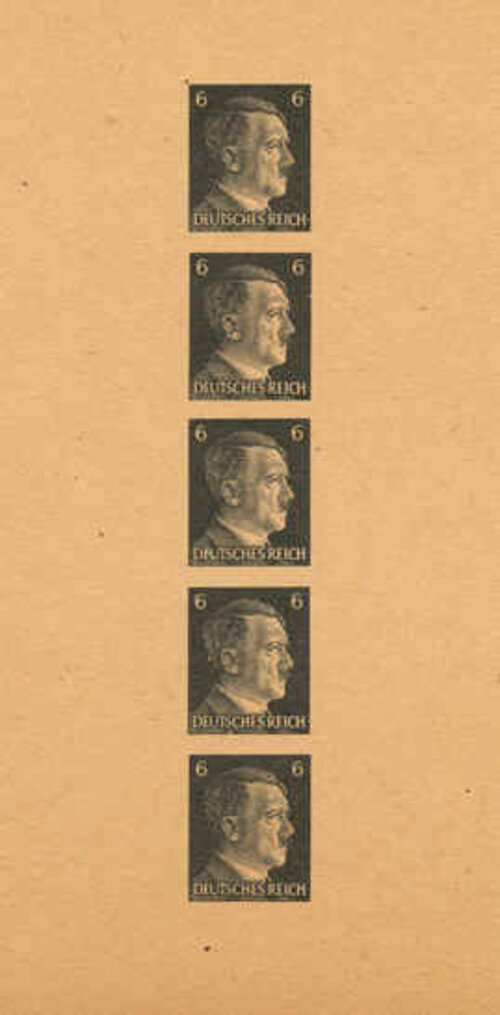
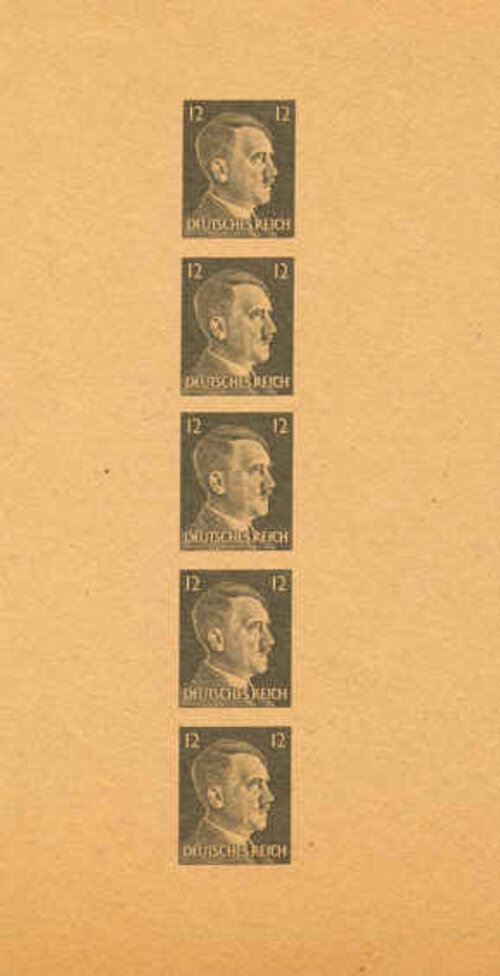
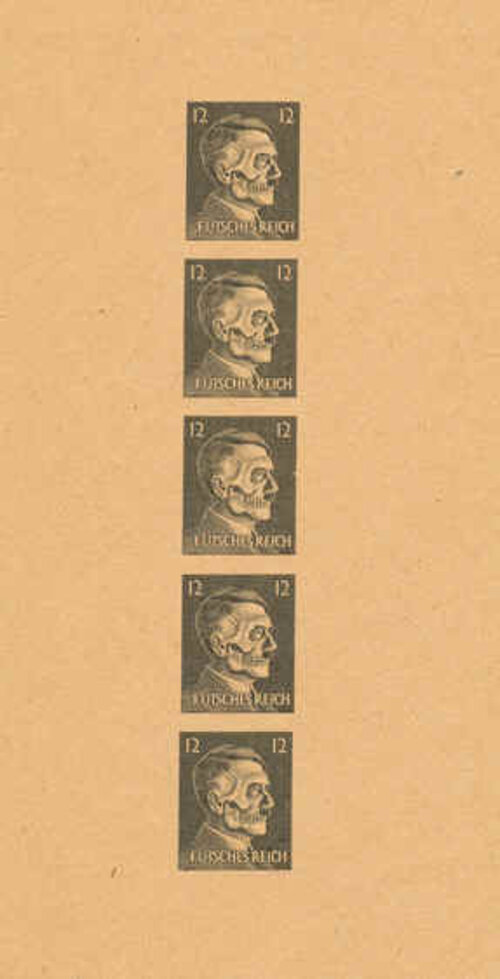
Proofs of the Hitler Forgeries and Parody
From time to time proofs of these forgeries are offered at auction. They are quite expensive. Above we show vertical slices of the three sheets in black proof format. In 1985 three such vertical slices of 5 images with a single horizontal proof of the skull parody was sold for $2,500.



Photographic negatives of the Hitler Forgeries and Parody
These are the photographs from which the plates and stamps were created. The negatives are signed by Robert Allen who supervised the OSS print shop in Rome.
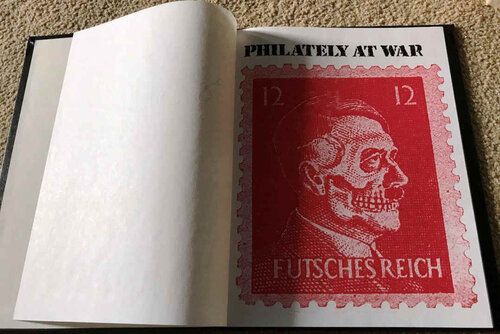
Philately at War
This book was published in 1990 by Thompson Publishing, Colorado Springs, Colorado. It was meant to be used as a history book, a catalog, and a scrapbook. I add it only because one of the main photographs in the book is this large image of the Hitler skull parody.
In neutral Switzerland, OSS maintained a headquarters in Bern beginning in May 1942, using the diplomatic cover provided by the OWI. There, the OSS (headed by Allen Dulles, who arrived in November 1942 and operated as code number 110, with cover name “Mr. Burns”) and the OWI (under Gerald Mayer, whose code number was 678) cooperated extensively on production of propaganda, and official correspondence on this subject seems to make little distinction between the offices.
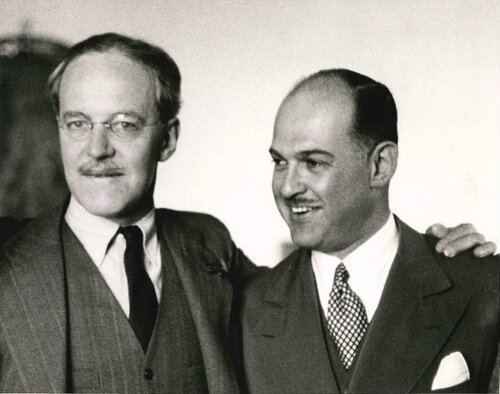
Allen Dulles Chief of OSS and Gerry Mayer Chief of OWI Courtesy of Richard Thorner
We cannot say for sure that this is Gerry Mayer (at right) with Allen Dulles, but the photograph was found in a book belonging to Mayer. If this is his picture it is the only one I have ever seen of the secretive “spy.” Gerry Mayer was the Chief of the United States Office of War Information (OWI) in Bern, Switzerland and the “Special Assistant” to the American Ambassador. He was of German Jewish descent and spoke perfect German. His apartment was at Jubilaumstrasse 97. Mayer sent thousands of leaflets, pamphlets, newspaper, brochures and other printed matter to the enemy during the war. Mayer worked closely with Allen Dulles and was of inestimable help to him. The OWI and OSS offices were in the same Bern building, the OWI on the first floor and the OSS on the second, third and fourth floors of Dufourstrasse 26.
We find many comments on the partnership between the two men and their agencies in telegrams that Dulles sent back to headquarters in Washington D.C. For instance:
21 November 1942: I am working particularly closely with Mayer of OWI…
11 September 1943: I have shared budget with Mayer, and can now meet all reasonable expenses out of funds now at hand...
27 November 1943: Together with Bavarians, 678 and I are preparing the wording of such leaflets…
The Bern OSS unit operated from Herrengasse 23. The OSS established five sub-units in Switzerland: in Geneva, Zurich, Lugano, Ascona, and Basel. OSS operations were conducted with great caution to avoid exposure and arrest by the rigorously neutral Swiss.
The Swiss seem to have had good reasons for their absolute neutrality. Steve Clark says in The Third Reich Study Group Newssheet of September 2021:
Switzerland's armed neutrality during WW2 - The Swiss government considered it necessary to introduce military protection and mobilized its entire army of 430,000 combat troops in just 3 days. The Germans and Italians had detailed plans to invade Switzerland (known as 'Operation Tannenbaum') but, for reasons that are still uncertain, Hitler never ordered the invasion to commence.
Despite the neutrality, both the Allied and Axis powers regularly violated Swiss territorial locations, and resulted in U.S. and British aircraft being shot down while flying over Swiss territory.
Two CIA agents named Gordon H. Torrey and Donald P. Avery who were both propaganda stamp collectors and displayed their collections at CIA headquarters were tasked to write a classified “Secret” report on the subject of espionage and propaganda stamps entitled Postal Forgeries in Two World Wars. This report was classified until 1993 when it was released under the CIA Historical Review program. On the subject of “Cornflakes” they said:
The quality of the intelligence forgeries varied considerably. The British were by far the best because they were done by regular postage stamp production facilities in England. Those of the Americans and the French resistance were a good deal poorer, reflecting the cruder production facilities available in the field. It was apparently considered unnecessary to create exact reproductions for mass mailing purposes, and imperfections were probably unavoidable because of wartime shortages of material and technicians. A major problem in some British and all American issues was color control, achieving and maintaining precisely the right mixture of the printing ink; in wartime this is a problem even for legitimate postal administrations. Field production required substitute printing methods as well, with photolithography replacing engravure. Paper shortages and the apparent lack of suitable perforating machines led to other major technical discrepancies. But the imitation of watermarks on postal paper proved unnecessary: the watermark is undetectable once the stamp is affixed to an envelope.
On one occasion the two agents put their collection on display in the small CIA museum just outside the cafeteria in the Langley headquarters. I stopped to view it on the way to lunch. It was entitled Postal Forgeries and Propaganda Stamps of Two World Wars. On four glass shelves were full sheets of the OSS forged German stamps, a Hitler birthday sheet, and other related items such as a copy of the clandestine newspaper Das Neue Deutschland.
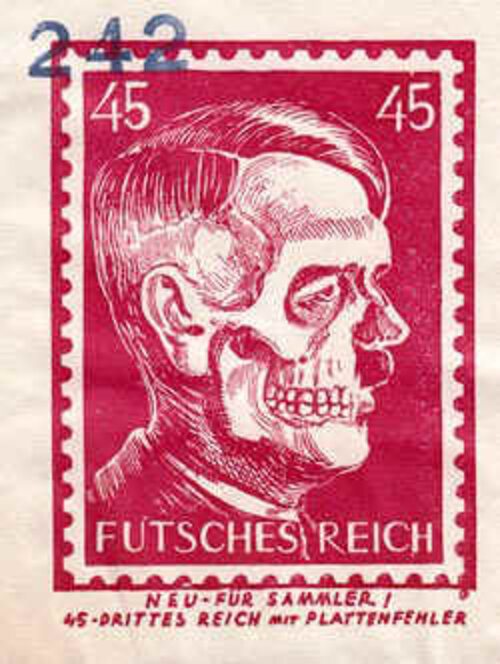
A 45-Pfennig Hitler-head Variant
There is an interesting variant of the OSS Hitler skull stamp that was produced by U.S. agents in Berne. The 45-pfennig propaganda variant depicts Hitler more crude, skull-like and horrific than the regular OSS parody stamp, and the “45” denomination probably indicates the year 1945. The text on the stamp is Futsches Reich. There is what appears to be a hand-written propaganda message in German just below the stamp that says:
New for philatelists
45 - Third Reich with plate flaws
The German is oddly written so was probably penned by an American. Specialist Wolfgang Baldus thinks that the OSS might have planned to make people believe that German stamp dealers were offering the “45” stamp. To make it look like a real stamp they drew the perforation and added a black area around the perforation. The German inscription was added to give the impression that the stamp was offered by German dealers.
Specialist Lee Richards saw a copy of the above variant in the OSS collection in the Hoover Institution Archive. Researcher Wolfgang Baldus also found a copy during his research. It is important to point out that although this appears to be a stamp stuck on a piece of paper (what a philatelist calls a “cut square” when one wants to save a stamp and cuts it from an envelope), the stamp is actually printed on the gummed sticker as is the text. Although it was made to look like a stamp glued to paper, it is simply an image of a stamp printed on paper. The overall size of the label is 7 cm x 9 cm. The stamp printed on the label is 6 cm x 7.5 cm. The stamp appears to be about twice the size of the normal Hitler-head, and this was probably done to make reading the text easier. Note the OSS file code “242.”
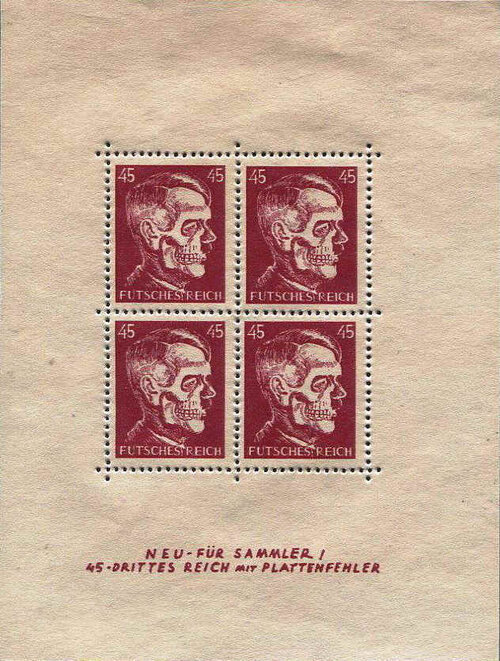
A Fake sheet from Taiwan
If we show a genuine OSS parody of a German postage stamp can the fantasies be far behind? In this case, no! Here is a modern forgery we found in 2017 being sold by a well-known fantasy dealer in Taiwan. The text on the sheet is the same as on the stamp:
New for philatelists
45 - Third Reich with plate flaws
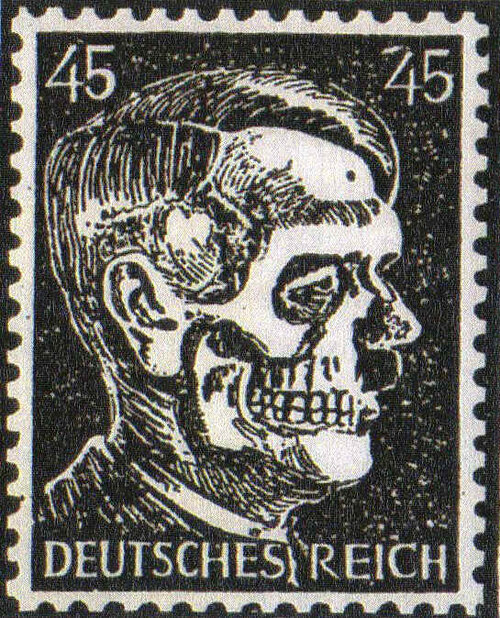
Black and white Hitler parody
A black and white image of a similar 45-pfennig Hitler parody was depicted in the January 1945 United States 12th Army Group propaganda newspaper Frontpost. The Twelfth United States Army Group European Theater of Operations history book entitled Publicity and Psychological Warfare 1943-1945 says about this newspaper:
The Frontpost was made up and written like a newspaper, not a leaflet. It contained news, a map of the western front, features, a news picture, a column, a bit of German sport news, a riddle — but no propaganda harangues, no editorializing, no overt preaching. The first issue also contained a feature which continued in every subsequent copy and later was transferred with success to the radio: a column called "Der Yankee Spricht" — "The Yankee Speaks."
An illustration of a Hitler skull stamp almost identical to the OSS variant above, but labeled Deutsches Reich appears on page 4 of the propaganda newspaper. The caption of the illustration is:
This draft of a new German postage stamp for 1945 was drawn by a German prisoner of war.
Werner Bohne says in his May 1996 GPS Reference Manual of Forgeries that the above variant is a postwar fraud privately produced after the war. I believe Werner made this assumption after reading an offer by an American philatelic dealer who offered the above red stamp with the comment:
The stamp must exist but a copy has never been found.
In 2012, an eBay dealer offered single reproductions of the 45 pfennig skull stamp in color and black and white and a souvenir sheet containing a block of four stamps with the text Der Teufel ist Tot. (“The Devil is dead”). I don’t think that the 45 pfennig skull images have appeared anywhere else so I suspect he took the images directly from this article. Secondary buyer beware!
The corresponding text said in part:
Futsches Reich '45' ~ a variation on the familiar Hitler Death's Head issue produced during World War II. Although this design originated during the war I'm not clear that it was ever produced on a stamp before this. These labels are not intended to represent any real or issued stamps and have no postal value. Printed on dry gummed stamp paper. US $2.98 each.
Wolfgang Baldus believes that the red Futsches Reich variety was done first because the lines of the drawing are much finer. When he placed one “stamp” over the other the perforations matched exactly so he believes that the black and white Deutsches Reich variety was simply redrawn with the new words and the image retouched with thicker lines to make it stand out in the coarser newspaper printing.
Two such labels with the image of the 45-pfennig stamp have been found with the block-stamp code “242.” The OSS filed all of their Berne productions with large block numbers in either blue or black ink. This indicates that it was filed in the OSS archives and although the American dealer did not realize it, he probably had a very rare and valuable propaganda parody in his stock.
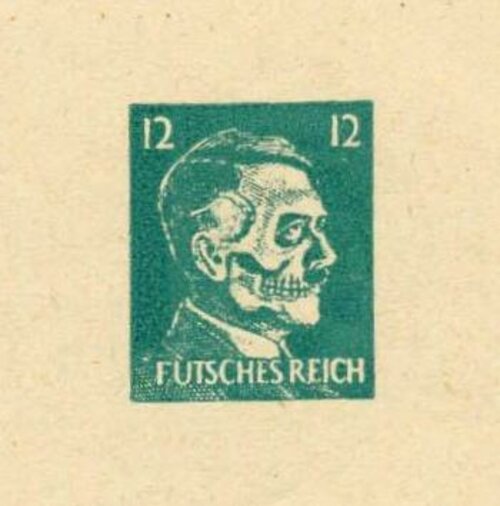
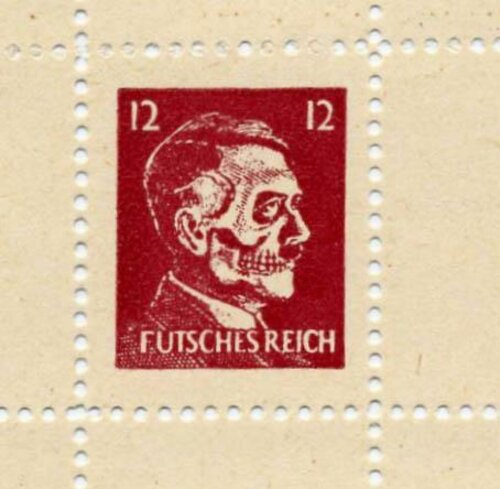
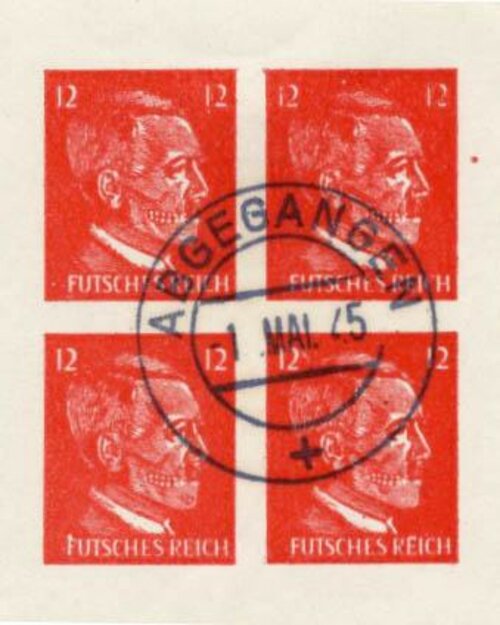
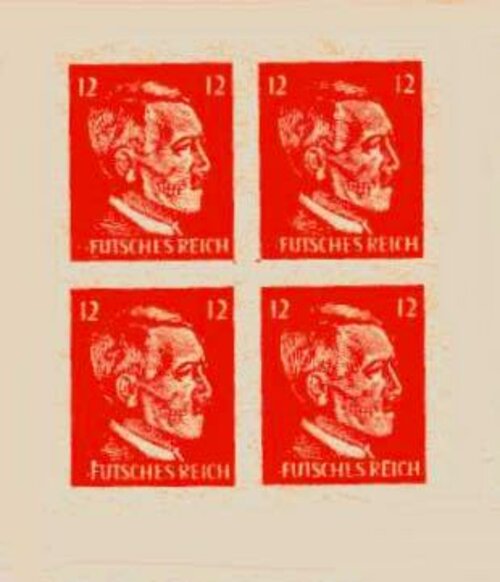
Reproductions and facsimiles
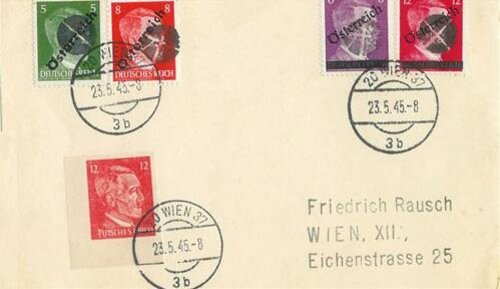
Worthless Envelope with Fake Copy of OSS Hitler Skull Parody and Bogus Cancel
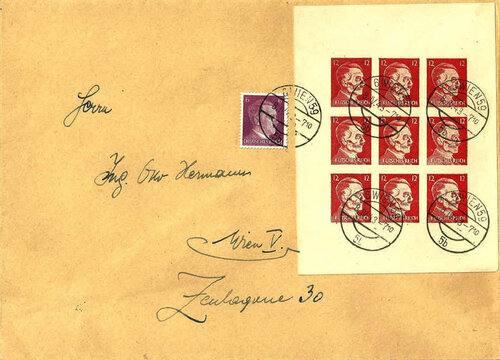
Another Fake Envelope with Hitler Skull sheet of nine never made by the OSS
A word to the wise. Because of the historical interest in the OSS Cornflakes stamps, the Hitler skull stamp is sometimes offered for sale or auction. The normal price for a single 12-pfennig skull genuine parody is about $25. Because there are always people looking to make a fast buck, forgers and conmen have produced a whole series of Hitler skull facsimiles and reproductions. These stamps have no value. They are found in singles and blocks of four or nine, in green or red, perforated or imperforated, and sometimes with a fake cancel. We show a selection of such worthless fakes above.
On 5 April 1937, Germany issued a souvenir sheet in honor of the 48th birthday of Reich Chancellor Adolf Hitler. In the center were four identical dark green 6-pfennig stamps showing the face of the German leader. An inscription at the bottom of the sheet read "WER EIN VOLK RETTEN WILL KANN NUR HEROISCH DENKEN" ("He who wants to save his people must think heroically").
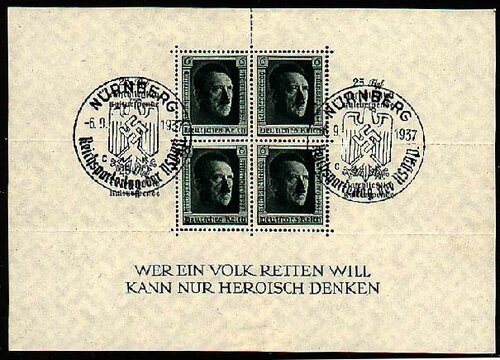
Genuine Hitler Birthday Souvenir Sheet
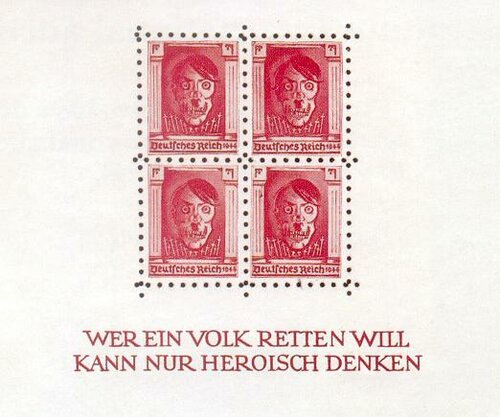
The OSS red Hitler Birthday Sheet
The OSS produced a propaganda parody of this sheet meant to attack and ridicule Hitler and the Nazi Party. One of the earliest mentions of the propaganda sheet appears in Forged Stamps of Two World Wars, by L. N. and M. Williams, Verdant Press, London, 1954:
The Allied propagandists represented Hitler on numerous occasions as the personification of death itself, and this idea was expressed in several parodies of stamps put out by the Allies during the later stages of the war. The first intimation philatelists had that a Hitler "death's head" or "skull" stamp existed, came when the Roosevelt collection was dispersed. During the second auction a miniature sheet of four, copied from the miniature sheet issued by Germany in 1937 to mark Hitler's 48th birthday and with the same inscription at the foot but with each stamp showing a skull and a row of crosses as the centerpiece, realized 90 pounds.
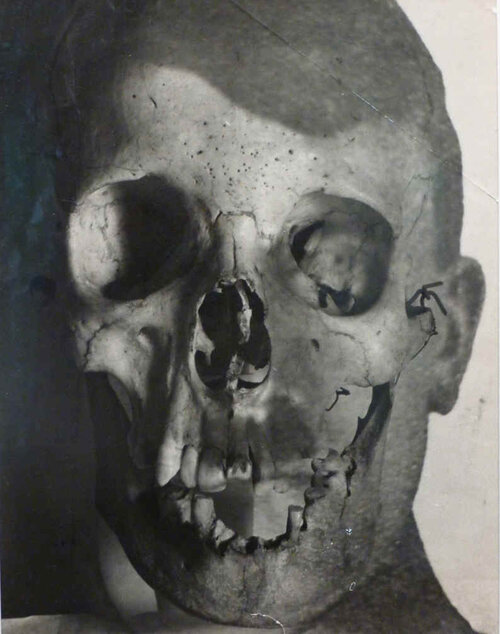
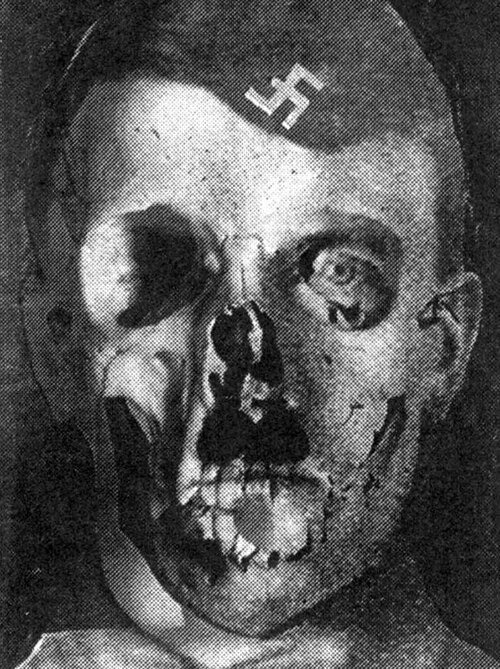
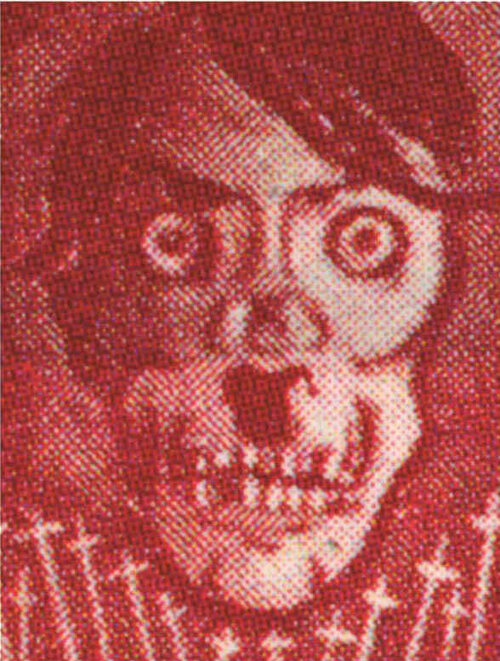
Erwin Blumenfeld's photomontage of Hitler
In the Cinderella Philatelist of April 1963, Jan Kindler mentions the image on the stamp:
I can only add that the apparent source of its design was a photomontage created by the photographer Erwin Blumenfeld in 1932. It was exhibited at a show in Paris in 1937 but was removed after a protest by the German Government. Nevertheless, it became well known and the propaganda label was clearly influenced, if not actually suggested, by the trick photograph.
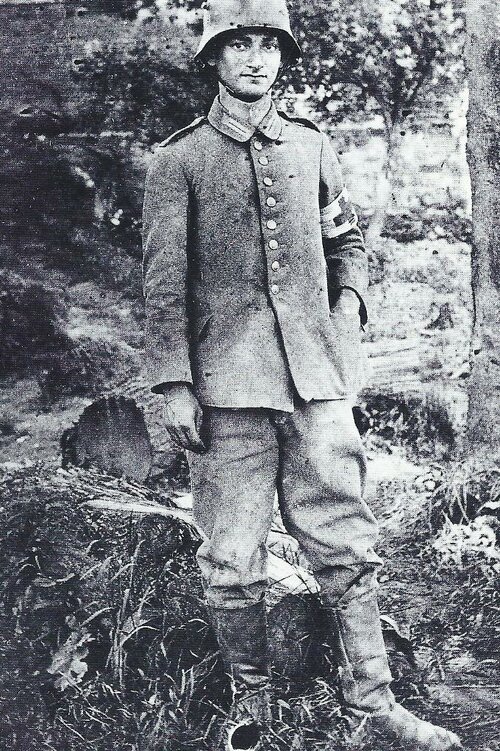
Blumenfeld during WWI in France
Blumenfeld is an interesting character. He was a German Army ambulance driver in WWI. However, he was a Jew and by the time Hitler rose to power he could see the handwriting of the wall. Blumenfeld himself stated in Eye to I: the Autobiography of a Photographer, Thames and Hudson, London, 1999:
But more to anyone else, I owe a debt of gratitude to Schicklgruber, the Fuhrer. Without him I would have slumped down to the Dutch swamps, and without him I would have never had the courage to become a photographer. He forced me out of my ivory tower and into real life. As a gesture of thanks, on the night when he seized power [30 January 1933], I did a photomontage superimposing his ghastly features onto a skull and ran with it through night, drunk, for nearly sixteen miles from Amsterdam to Aerdenhout. In 1942 a million copies were dropped over Germany as American aerial propaganda. Heil Hitler!
The photographer's remembrances appear to have been less than reliable. There is a belief among some that this German Ambassador’s protest never occurred, and if it did, some doubt about what photo-montage was actually exhibited. This may because Blumenfeld created the montage in two formats, one with a swastika on Hitler’s head, and one without the swastika.
Dr. Wolfgang Brückle of the Kunsthistorisches Institut Universität Zürich says in Rearranging the Dictator’s Face: Erwin Blumenfeld’s Last Political Photographs:
Adolf Hitler’s face was a source of fascination for his contemporaries, much described and discussed by his admirers and opponents alike…Many artists who set out to attack the Nazi movement and regime made Hitler’s face the focus of their work. Erwin Blumenfeld was one of them…Blumenfeld produced several portraits of Hitler from around 1933. He had found a human skeleton intended for anatomical studies…and had used it for a double-exposure portrait of the owner…However, Blumenfeld’s semantic field expanded when he thought of combining the skull with Hitler’s face. The message of this arrangement is clear: Hitler deals in death, and he deserves death.
In addition, Claudia Schmölders says in Hitlerfresse - Die visuelle Demontage des Hitler-Mythos, in: Das Jahrhundert der Bilder, [Book 1]: 1900 to 1949, Göttingen: Vandenhoeck & Ruprecht, 2009:
Blumenfeld's "Hitlerfresse" [Hitler’s Face] photomontage was printed as a stamp in 1937, on a sheet with four 6 Pfennig stamps. Allan Dulles from the Office of Strategic Services said it was printed in Switzerland and that he smuggled it into Germany. It appears the forgery was produced by Raymond Schuhl, aka Salembier, who was from Paris and may have been Blumenfeld's friend.
All of this is incorrect. There was no OSS or Dulles in Switzerland in 1937 and the United States was trying to remain isolationist at the time. Clearly, Schmölders has confused the original German stamp sheet with the later OSS propaganda sheet.
Dr. Wolfgang Brückle of the University of Zurich also mentions that Blumenfeld says his skull photomontage was dropped by US aircraft over Germany in 1942. We know that is not true because the first American propaganda leaflets dropped over Germany by U.S. aircraft were prepared by the Office of War Information coded “USG” and disseminated starting in mid-1943.
Having said all this, the similarity of the Blumenfeld photomontage and the OSS propaganda sheet is so obvious that we must believe that the image was used as the inspiration of the Hitler full-face skull stamp.
The H. R. Harmer Inc. catalog offering of the Franklin Delano Roosevelt postage stamp collection was held the evening of 4 April 1946. The Hitler birthday parody sheet was lot No. 738:
Propaganda in Germany, faked Hitler sheet, dark red, showing skull and cross bones design, printed in Switzerland and sent to widows and next of kin of German casualties. See next lot.
The following lot, No. 739 read:
Propaganda in Germany, Underground newspaper Frankfurter Zeitung, issue 451, secretly printed and introduced by clandestine means into Germany where they were mailed to individuals whose address appeared in the death notices of soldiers who are reported to have 'died for the Fatherland,' 6 pages.
Hitler is shown in full face over a field of 13 burial crosses. The 6-pfennig denomination has been replaced by a gallows at the top of the columns at the upper right and left of the stamps. There has been a slight addition to the text at the bottom of the stamp. "Deutsches Reich" ("German Empire") has been changed to "Deutsches Reich 1944."
Stamps of 6 July 1946 had a brief article entitled "O.S.S. Propaganda Stamps." A letter from Allen Dulles (OSS Switzerland) to General Donovan was reprinted in part. This letter told of the production of a:
...so-called Hitler stamp showing him as a death's head with skull and crossbones, which Gerry Mayer (OWI Switzerland) and I got out as black propaganda and smuggled into Germany in as many copies as we could get over the frontier.
We learn much more about the American propaganda operation in Switzerland from William Warren Wertz Jr. whose University of California thesis for a Master of Arts in Political Science is entitled Clandestine Propaganda from Berne (1942—1945): United States Leaflets Subverting Hitler. Wertz used the Gerald Mayer collection of OWI propaganda leaflets from Berne housed in the Main Library of the University of California at Berkeley for reference.
He says that from December 1942 until V-E Day the chief of the Berne OWI Outpost was Gerald M. Mayer. Officially, Mayer was listed as Assistant to the United States Minister to Switzerland from 1942 to 1945. In his report on OWI Berne activities from December 1942 until December 1943, Mayer summarized his printing and distribution efforts. The report implies that output was often sporadic. The Swiss Police presented a constant threat and nuisance as far as clandestine operations were concerned. In fact, Mayer says that the Swiss were a worse problem than the Germans. With the German Army on the Swiss border looking for an excuse to invade, I suppose that is to be expected. During the first year the OWI output was 1,269,500 black and white leaflets and 19,000 brochures. Notice that Mayer never mentions the OSS although we know that he worked hand-in-hand with them.
Gerald Mayer is mentioned quite often in the WWII classified magazine Outpost News; U.S. Office of War Information Outpost Service Bureau. Some of the comments are:
October 1943: Twice weekly, Gerald Mayer sends a news service called U.S. Sidelights to 133 papers…
December 1943: Gerald Mayer in Switzerland reports that Budapest newspapers are using large amounts of United nations’ press releases.
May 1944: Gerald Mayer reports from Berne that Exchange Telegraph now monitors almost all American relayed broadcasts…
July 1944: Gerald Mayer, Chief of Switzerland Outpost reported that material from Berne on D-Day was so good that 125 Swiss newspapers printed three advance releases.
So, was Mayer just OWI or was he also OSS? An interesting letter dated 9 April 1942 indicates that he may have been both. The letter, from OSS head William J. Donovan says in part:
This is to advise you that your headquarters have been changed from Washington D.C. to Berne, Switzerland, effective entrance on duty at your new headquarters…The transfer is not for your convenience, but is in the best interests of the Government.
I say in an earlier article on American PSYOP in Europe:
Although officially appearing to be on a rank equal to Dulles, Mayer was in practice Dulles’s subordinate. In fact, Gerry Mayer and his OWI team were brought under the OSS at some point in the war, probably in late 1942. The OSS awarded Mayer a certificate that states:
Gerald M. Mayer honorably served the United States of America as a member of The Office of Strategic Services.
William J. Donovan, Major General, USA, Director The 1st Day of October 1945.
Looking back on all the confusion taking place between the American propagandists and spies, the Swiss, the Germans on the border and the French forger, we can see the operation as through a clouded glass. It appears that the OWI printed their legal and acceptable propaganda each day and the OSS printed their illegal black propaganda each night. Everyone was on constant alert because should the Swiss decide to take strong action, it would be very embarrassing for the American Government. This kind of OWI/OSS partnership seems to have been the standard operating procedure in SHAEF since 1942.
Before we leave this particular propaganda item, the Hitler birthday sheet, we should point out the amazing difference between collectors of leaflets and collectors of stamps. The average American leaflet dropped on Germany is normally priced at about $20. Most Americans cannot read German and as a result have little interest in owning a piece of paper that has text they do not understand. If the illustration is really interesting, perhaps showing Hitler, or the SS or even an anti-Semitic vignette, collectors might spend as much as $50. In general, none of the WWII leaflets to Germany has any great value.
However, if the leaflet is in the form of a stamp or a postcard, philatelists now enter the field. They will pay an enormous amount for a leaflet in the form of a postal product. I have seen Russian propaganda postcards bearing fake stamps sell from anywhere from $500 to $1300. I have watched the Hitler birthday sheet over the years and the genuine copies have sold at auction for anywhere from $360 (the very first one in 1946) to $42,700 in 1995 at the height of its value. As additional sheets were discovered the price dropped to $17,400 in 1967 and as little as $5,046 in 2009 when three sheets came on the market. I am currently aware of approximately 28 Genuine red sheets extant.
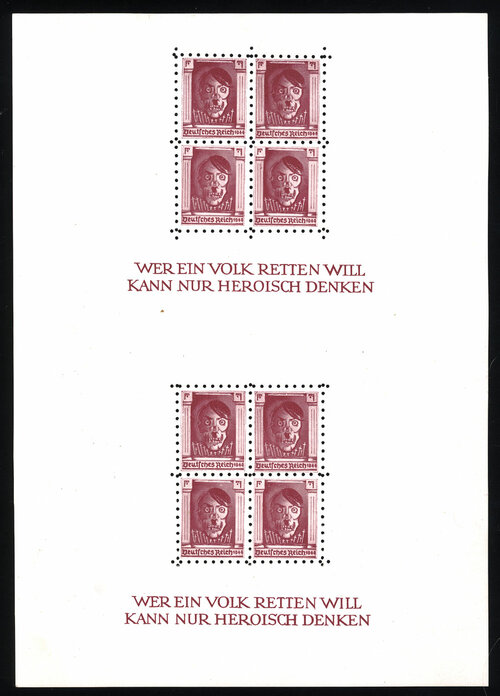
OSS Uncut Sheet of Two Hitler Birthday Sheets
Cherrystone Auctions of New York City on 28 October 2009 offered an uncut sheet of two of the American OSS Hitler birthday sheets estimated at $47,500. The sheets were a vertical uncut pair in brown violet, never hinged, and described as very fine.
The sheet was accompanied by a 23 September 2009 Gerhard Krischke (Hannover) certificate stating that:
…this is the absolutely unique complete sheet and without question the most important rarity of the World War II Propaganda issues.
So, if this were a simple leaflet showing Hitler in red it might be worth $25. As a philatelic item it is worth $47,500. Go figure!
Charles Cruickshank mentions the curious relationship between the OWI and OSS in The Fourth Arm: Psychological Warfare 1938 – 1945, Davis-Poynter, London, 1977:
The Americans explained that General Eisenhower found it impossible to draw a clear line between subversive propaganda and subversive activities, and had accordingly ruled that when OWI (the propagandists) and OSS(the Saboteurs) wanted to discuss any project with the military authorities they must be accompanied by a member of the other organization.
Could this policy have worked its way into Switzerland and been the reason the two organizations often shared printing plants and operations? There is no proof of that, but it would help to explain the blurred line.
A map of the geographical location of the Berne outpost indicates that it was well spread out. Berne was the outpost headquarters, and there were depots in Basel, Zurich and Geneva and a print shop in Lausanne. Eight teams were charged with distributing the propaganda to Germany, France, Austria and Italy. They were kept compartmentalized and no team knew of the existence of any other.
Team Valmy was responsible distribution in France.
Team Mail was in charge of clandestine mail into Germany including propaganda newspapers.
Team Navig used the Rhine to send messages into Western Germany.
Team Rails sent propaganda using the railroads. This entire team was arrested by the Germans in late 1943.
Team Waterloo was made up of Communists who used their own contacts for placing propaganda into Germany.
Team Nibelungen was the organization “Free Germany.” They also used their own contacts.
Team Niagara only operated near the German-Swiss frontier.
Team Garibaldi only distributed leaflets into Italy. After Italy surrendered in 1943 they were shut down.
Team Parsival was a roving team of writers and occasional collaborators acting independently.
There are about 411 items in the Mayer Berne collection. About four percent of the material is black, nine percent is white and the remaining 87 percent is grey or unsigned. They breakdown as follows:
172 Pictures (photos, cartoons). 141 Leaflets (single page). 47 Papillons (Small stickers). 45 Newspapers, newssheets. 15 Seed Packets (with propaganda enclosures). 6 Letters (Generally with a genuine 10 pfennig stamp and propaganda enclosure). 5 Pamphlets (2 pages, folded). 5 Stamp collections. 3 Cigarette papers, packs. 5 Laisser passes. 2 Identity cards. 1 Hospital Permit. 1 lnvalid Card. 1 Match book. 1 Auto Circulation Permit. 3 Tobacco Ration Cards.
OSS Patch
The printing operation in Switzerland is mentioned in War Report of the OSS, The Overseas Targets, Volume 2, Kermit Roosevelt, Walker and Company, NY, 1976:
Joint OSS/OWI operations were worked out in the field of propaganda warfare. The OSS mission had early established contact with a Frenchman, known under his cover name of 'Salembier,' who had been one of the French Deuxieme Bureau's chief propaganda artists in World War I. He knew his trade and was set up in business, operating from Geneva, by OSS and OWI jointly. Millions of pamphlets, leaflets, cards, postage stamps and every form of literary propaganda were printed and smuggled into Germany and Fascist Italy.
The man with the pseudonym Robert Salembier was actually Raymond A. Schuhl, code-named “Mutt.” His code name had a code name! He had been a French Army propagandist in WWI who had served in the 6th Section of the French Deuxieme Bureau until the fall of France and volunteered to do the same for the Americans in WWII. Although his religion is listed nowhere in official documents I was informed by another researcher that he was of the Jewish faith.
All of the people that either worked for the OSS or were of some interest to them were named in a list. We don’t find Schuhl or Salembier in that list so it is possible that a French national forging documents for the OSS was too secret to list. Every individual also received a code number, and we don’t find Schuhl in that list either, but we do have a clue. There is an un-named person (almost all others are named), numbered 677 that simply says “Employed by OSS in Switzerland.” I suspect this is Schuhl because a Dulles telegram dated 11 September 1943 says:
For the past six months the person numbered 677 has been working full-time for us, and, since it is not wise to transmit reports by cable, we have been doing a great deal more along the lines indicated than you know.
So, 677 was doing work that Dulles did not want to put on paper. This is almost always the case when you are talking about counterfeiting documents. Six months would take us back to March and we think Salembier was hired in February, but that could just be rounding off the numbers, or it could be that the forger was first hired for some specific contract jobs, and hired full-time a month later.
He seems to have worked for the Americans as early as February 1943. His pay was apparently in U.S. greenbacks and kept in the United States. On 5 February he asked for some of his money and was told [in a censored letter]:
I have talked with our Financial Attaché on the question of the possible release of some of your dollar fund in the United States. I suggest that when you are next in Bern you call at the legation…
Another letter on 6 June 1943 mentions that he also has funds in British bank. The letter from “D” (Dulles?) adds:
I have the greatest confidence in Salembier [Now using the code name] and would be glad to do anything I can to facilitate his obtaining funds to keep him and his family going here in Switzerland. He is useful to us in many ways.
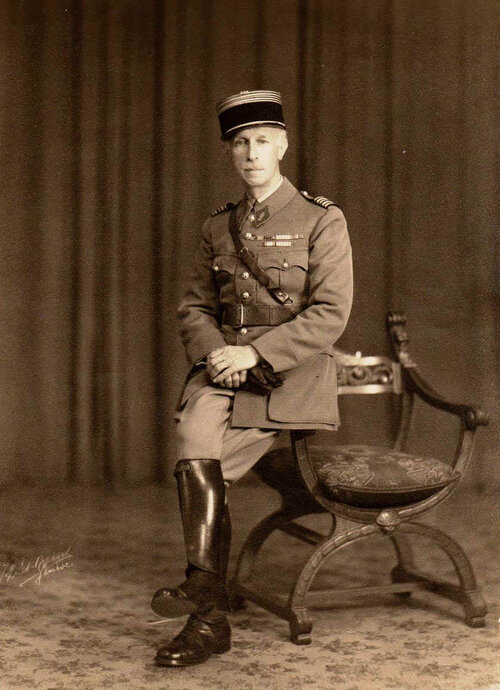
Raymond A. Schuhl (AKA “Robert Salembier”) as a Lieutenant Colonel, 1946
His cover was “Alsatian businessman.” It appears that Gerry Mayer [of the O.W.I.] was a middleman between Salembier and Dulles. I have a copy of a 16 September 1943 note from “G.M.M.” to Dulles giving “Mutt’s” phone number and stating that he was staying at the Hotel Regina, phone number 2-61-74.
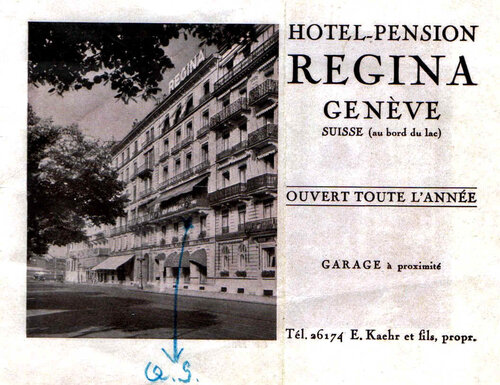
The Hotel Regina in Geneva Schuhl has marked his hotel room window on the photograph
Raymond Arthur Schuhl was born in Paris but lived in Sainte-Marie-aux-Mines, a small town in Alsace. Alsace had been integrated into the German Empire but Schuhl always had strong pro-French feelings. He had a perfect knowledge of German language and was able to speak with various regional accents, including Swiss.
When WWI was declared, he traveled to France and enlisted in the army. His intellect was apparently noted and he received several promotions ending the war as a Lieutenant. At some point late in the war he got involved in propaganda operations with his friend Jean-Jacques Waltz, who used the alias Hansi.
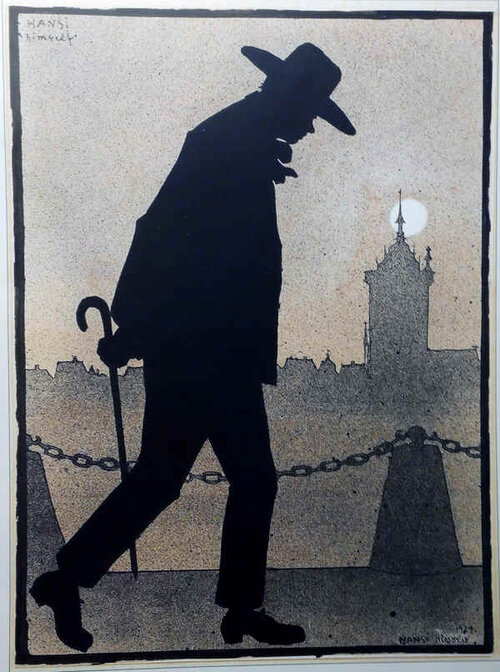
Hansi drew this self portrait silhouette of himself in 1929
Hansi was an Alsacian cartoonist, strongly anti-German and pro-French who produced many anti-German illustrations and cartoons before and during WWI. Hansi was imprisoned several times by the German authorities for making fun of the German military, culminating in a one-year prison sentence in July 1914. This caused a national outrage in France. Hansi eventually escaped to France, where he initially joined the military as a translator-officer. During the war he worked together with Ernest Tonnelat and Raymond Schuhl in a propaganda unit creating anti-German propaganda. Waltz later collaborated with E. Tonnelat to write the 1922 French-language book Through Enemy Lines - A three Years Offensive against German Morale that told of his work with Schuhl during the war. Hansi was awarded the Commander of the Legion d'Honneur, and the Croix de Guerre for both the first and second world wars. From an operational base in Switzerland they produced counterfeit German newspapers such as the Frankfurter Zeitung and enormous quantities of leaflets and booklets. The methods of dissemination were quite similar to those used by Office of Strategic Services in WWII. Once again the two Frenchmen would travel to Switzerland to produce clandestine anti-German propaganda. Like Schuhl. Hansi was awarded Commandeur of the Légion d'Honneur, Croix de Guerre 1914-1918 with palms, and Croix de Guerre 1939-1945 with palms.
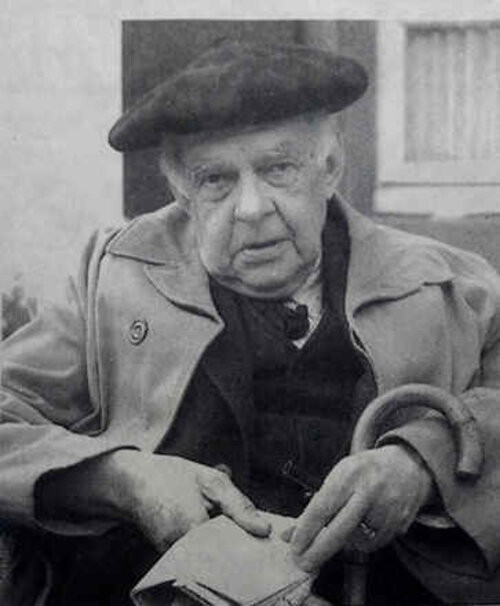
Jean-Jacques Waltz
We have mentioned Jean-Jacques Waltz, also known as "Hansi" several times in this article. Above is his very last photograph taken just prior to his death on 10 June 1951.
After 1933, Schuhl saw the danger represented by Hitler and the Nazi Party. He secretly stayed near Vichy for a brief time where the new French government collaborated with Germany (possibly gathering information), and then fled to Switzerland where he was able to get in touch with the Office of Strategic Services and become a trusted agent.
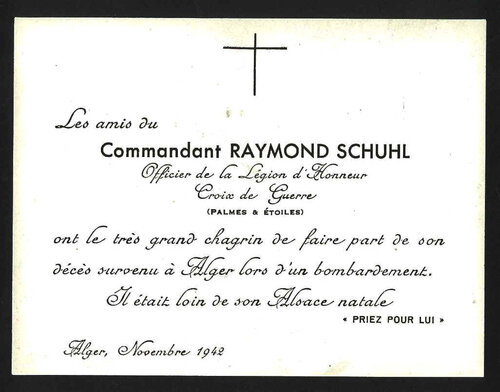
A Fake Death Notice for Schuhl Courtesy of Richard Thorner
At some point in 1942 Schuhl had apparently decided to join the Americans. Perhaps to hide his whereabouts and to make himself invisible to the Germans and to protect his family a death notice was printed stating that:
The friends of Commander Raymond Schuhl Commandeur of the Legion of Honor Croix de Guerre with Palms and Stars
Have the great sorrow to announce his death in Algiers during a bombing. It was far from his native Alsace. Pray for him. Algiers, November 1942.
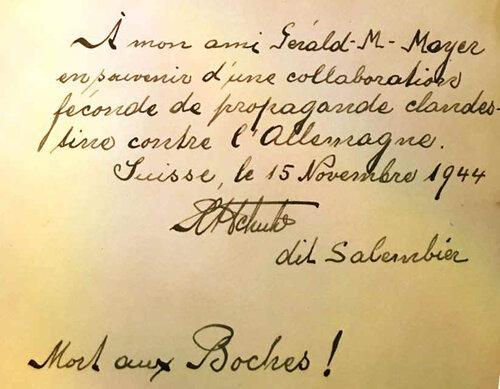
Death to the Boches Courtesy of Richard Thorner
Schuhl later autographed a copy of Hansi’s book: Through Enemy Lines - A three Years Offensive against German Morale, and dedicated it as a gift to Gerry Mayer who was OWI but secretly permitted the OSS to use his darkened printing facilities at night. I add it here because it shows Schuhl’s handwriting and signature and thanks his friend Gerry Mayer for his collaboration in producing clandestine propaganda in Switzerland against the Germans. The text is:
To my friend Gerald M. Mayer as a souvenir for a fruitful collaboration of clandestine propaganda against Germany. Switzerland, 15 November 1944 [signature of Schuhl] aka Salembier. Death to the damned Germans!
Schuhl and Mayer seem to be the best of friends. In May of 1946, a letter from Schuhl to Mayer in the Allen Dulles papers requests help with $99,000 in blocked funds in three New York City banks and is signed by the old codename “Mutt.” In December of 1946, both Dulles and Mayer wrote to Schuhl at the Hotel Regina in Geneva congratulating him on the first Christmas after the Allied victory.
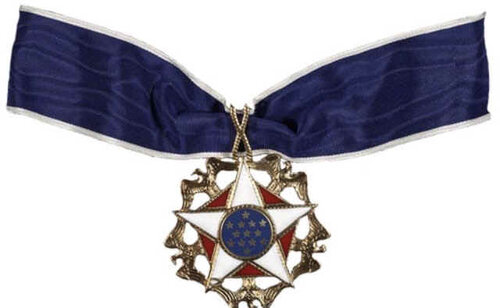
The Presidential Medal of Freedom
After the war Schuhl received the Presidential Medal of Freedom from President Harry S. Truman and was very proud of this award, among many others. France awarded Schuhl the Commander de la Legion d Honneur and the Croix de Guerre avec Palmes for both WWI and WWII. He died in Paris in 1956 of heart attack.
We also know that even before the start of Operation Cornflakes, Salembier was involved with postal propaganda. In late 1944, Eugene Warner, the Chief of Mediterranean Morale Operations met with the French forger to discuss sending propaganda mail into Germany through regular mail trains from Switzerland. Salembier told him that it could be done, but in only very limited numbers. As a result, MO Rome pulled out of this operation and told Salembier to prepare his own letters and envelopes in Switzerland. The Rome MO office was ordered to send Salembier 10,000 stamps to help in that operation. Rome then experimented with dropping fake mailbags, targeting Hungary. Two mailbags filled with propaganda were prepared in Bari, Italy and dropped in open country. Apparently the test was considered a success. This led directly to the Cornflakes project in early February 1945 where mailbags would be dropped along the railroad tracks in Germany.
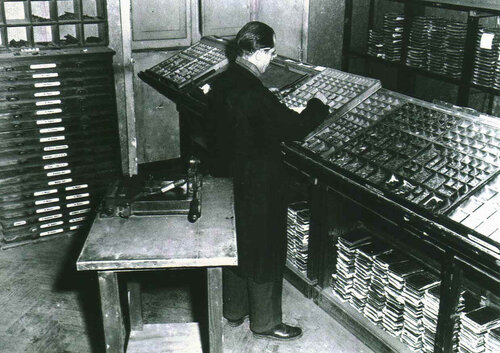
An OSS printer searches for specific German and Italian fonts among the vast number of type-face and plates at the printing plant.
Back in Switzerland, it is interesting to note that the OSS might have been printing propaganda in Bern, Geneva and Lausanne. A Swiss Ministere Public Federal document from their General Prosecutor dated 29 September 1944 in my Salembier file that states:
The “imprimerie Centrale de Lausanne” has printed propaganda material in violation of Swiss neutrality and that propaganda is an outrage to a foreign Head of State.
Consequently: The manager of the printing house will be punished in the event of a subsequent crime. All the material seized is confiscated. 4 copies has been sent to the Police of Sûreté de Lausanne.
Lausanne is city about 50 kilometers to the East of Geneva and 100 kilometers to the South of Bern. It is possible that this document was just added to the file to warn everyone that the Swiss were serious about the neutrality of their nation, but I think it is more likely that the OSS got caught preparing propaganda and this warning was placed into the clandestine printer’s file.
There must have been some rumor of a French plot against American policy because on 25 February 1945, Dulles recommends Schuhl for an intelligence job to General Eugene L. Harrison of the U.S. Sixth Army Group and says that he can be trusted. The letter says in part:
…My French friend will identify himself under the name Salembier…He worked closely with us for over two years, and also had a mission from the French Ministry of War…Extremely astute and if anyone can be of use in ferreting out the mystery I believe he is the man…He is of course a good Frenchman, but I don’t believe he would tolerate any French intrigue against us…
On 20 December 1946, Allen Dulles recommended Schuhl for a military medal but it was rejected. He said in part:
…Decoration for Raymond A. Schuhl, generally known as Salembier, an Alsatian who did some outstanding work for Gerry Mayer and me during the war…
The U.S. Army was not about to give a French national a medal for producing black propaganda in Switzerland in violation of Swiss neutrality. He did, however, receive a letter from President Roosevelt dated 30 October 1944 thanking him for efforts on behalf of the Allied nations.
Close to two dozen full Hitler birthday sheets and one broken sheet are known to exist. The sheets are readily identified by the line perforations, which appear different in each known sheet.
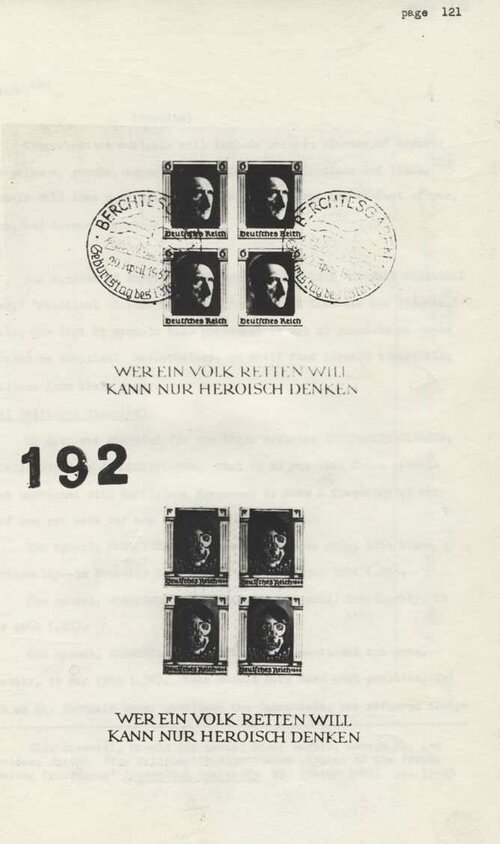
The Birthday Sheet with the “192” File Number
In 2008, researcher Lee Richards learned that a collection of OSS propaganda originally belonging to Gerald Mayer of the OWI who worked hand-in-hand with Allen Dulles of the OSS had been donated to the University of California, at Berkeley. The collection was studied by author William Warren Wertz Jr., who in 1949 published a 256-page Master’s dissertation about the theory of propaganda analysis, entitled: Clandestine propaganda from Berne (1942-1945): United States leaflets subverting Hitler. There is an illustration of a Hitler sheet with the official OSS hand-stamped file number “192” on page 121 of this dissertation. No text accompanies the illustration, just the image of the genuine German sheet and the OSS parody.
The first of the sheets offered to the public was in a small group of propaganda items given to President Franklin Delano Roosevelt by General William Donovan, chief of the Office of Strategic Services (OSS), on 24 October 1944. King Farouk of Egypt eventually acquired the Roosevelt red sheet. The second sheet came from Georges Meyer, former director of services for the French War Ministry of Press and Information. The sheet probably was a gift from Salembier. This sheet had a large OSS reference number "192" stamped to the left of the stamps. A second "192" red sheet belonged to Gordon H. Torrey, a former OSS and CIA employee. This sheet appeared in a 1997 exhibit at CIA Headquarters, in Langley, Virginia. Other sheets are in Germany, Great Britain, Australia, France, and three are in the United States.
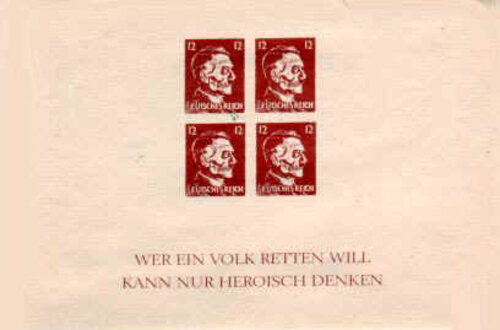
Fake Hitler Birthday Sheet
The rarity of the genuine OSS Hitler birthday sheet made it a target for scammers and con men. This fake sheet shows ingenuity. The forger has taken the OSS skull parodies showing Hitler in profile from the sheets of 50 and placed them in the birthday sheet where Hitler should be depicted looking straight at the viewer. It is a nice fantasy product worth perhaps $5 to $10 as a conversation piece. It has no value as either a philatelic or PSYOP product.
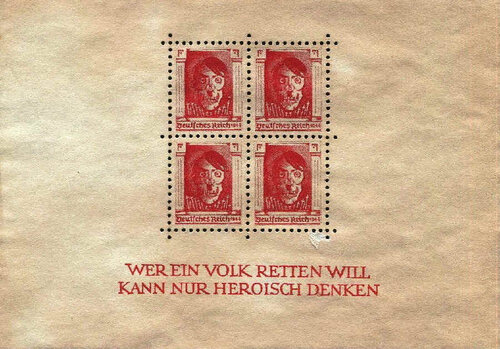
The Taiwan Forgery
Other fake sheets are produced in Taiwan and are printed on regular paper and sometimes printed on a very aged brown paper. That is odd because the genuine sheets are almost always on a bright white paper. Note that the Taiwan forgery has 14 burial crosses on the stamp instead of 13. I don’t know if the printer had a sense of humor or could not count. The Taiwan printers have also forged the green Hitler birthday sheets we show below.
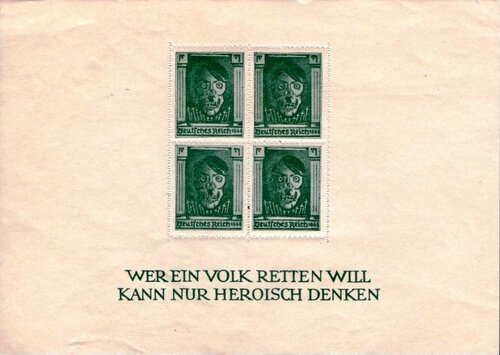
OSS Green Hitler Birthday Sheet
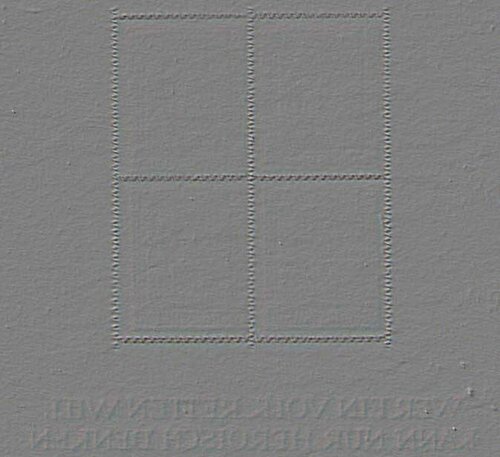
The back of the OSS Green Hitler Birthday Sheet showing the rouletting
There is also a green version of the OSS Hitler birthday sheet. It is one of the great mysteries of espionage philately. They are rarer than the red sheets and only about a half-dozen are known to exist. Unlike the red sheet, the green sheet is not perforated. Instead, the stamps are separated by rouletting. There are a number of official documents and references that mention the red sheet so there has never been a question about its legitimacy. There is not a single official document that mentions the green sheet so it has always been questionable. There are fewer green sheets than red sheets. The rouletting shows only indistinctly in photographs or photocopies, thereby denying easy identification of individual sheets.
The first green sheet appeared in Bern, Switzerland sometime before 1962. We know nothing about the origin of the sheet but there was an OSS station in Bern so that places the sheet at the heart of OSS intrigue. The sheet was described as having two vertical folds since they were folded and distributed in envelopes. The size of the sheets will be mentioned again later. The propaganda sheet eventually was sold to an American collector for just over $2000.
A second sheet appeared sometime prior to 1978. The sheet had two staple holes in the right margin. It was claimed that an official OSS memorandum had been attached to the sheet. The memorandum allegedly mentioned the fact that the original German sheet was green and therefore the OSS parody also should be green. In addition, the memorandum questioned the advisability of producing the parody, since it would not fit on a standard German envelope while still leaving room for an address. The owner of this second sheet, the German philatelic expert Werner Bohne, claimed to be under a constraint never to release this memo. I argued with him one afternoon in his Florida home about the importance of actually seeing this mysterious document but he refused to show it to me. It has never been seen and therefore many doubt its existence. That sheet was eventually sold in Europe for $4000. Bohne died in 2011. After a number of more recent discoveries (see below) that implied that the green sheet was in fact an OSS product; this sheet with staple holes was auctioned in Sweden in 2012 and sold for $22,605.
A third sheet surfaced in the St. Paul, Minnesota area. Other sheets are in private collections in the United States.
Another green sheet belonged to Gordon H. Torrey, who worked for both the OSS and the CIA. This sheet appeared in a 1997 CIA exhibit at their headquarters in Langley, Virginia. It was part of a collection of propaganda and espionage items exhibited by Torrey and Donald P. Avery in the small CIA in-house museum.
In 2008, researcher Lee Richards discovered a specimen of the OSS green Hitler birthday sheet in the Hoover Institute Archives at Stanford University. The collection consists of about 400 leaflets. Although the origin of this collection is unknown it was originally in an album as many of the leaflets were still attached to a backing paper and missing items from the collection were acknowledged with a paper label saying, “Supplies of this number exhausted.” The collection contains both OWI and OSS propaganda as might be expected from Bern, since both agencies worked closely together and used the same printing shops. As a result of this find and the earlier Gasquiel discovery, I think we can now say that the green sheet may be a genuine OSS philatelic parody.
Why the last vestige of doubt? Several reasons. First of all, there are three red sheets known to have been stamped with the OSS file number 192. No such green sheet has yet been discovered.
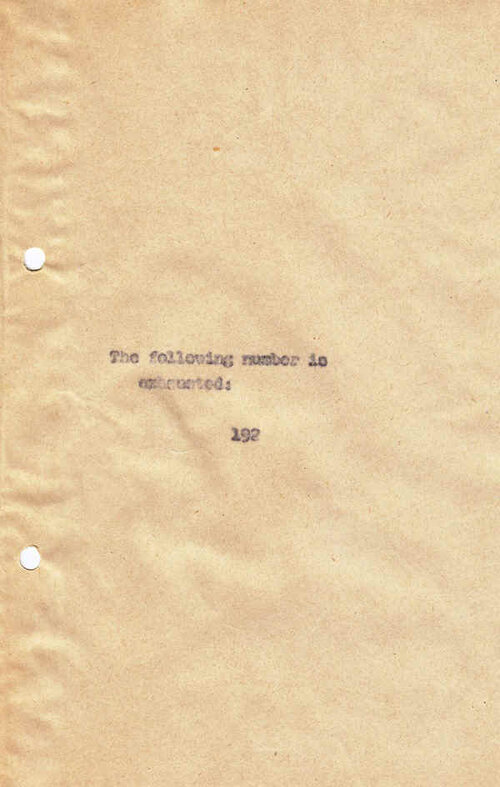
Backing page of Green Hitler Sheet
Researcher Lee Richards poses a puzzling situation. Lee has examined three almost complete collections of OSS Bern material, two at the National Archives and a third at the Hoover Institution Archives at Stanford University. In all three collections the red Hitler’s birthday sheet (OSS Bern code 192) is missing, with a printed label stating, “Supplies of this item exhausted.” In all three collections there is a green Hitler’s birthday sheet, but none bear an OSS Bern code – the only propaganda item in the collections to lack a code. Lee went so far as to say:
I’m starting to wonder whether that green Hitler death mask souvenir sheet has been “seeded” into these collections.
In addition, in all three collections the green sheet is misfiled far from code 192, which was assigned to the red sheet probably in October 1944: In the two National Archives collections, the un-coded green sheet is placed with code 307, the 12 pfennig Futsches Reich postage stamp or with the stamped OSS leaflet 311, ADOLF HITLER'S TESTIMONY: Why we marched to Russia. In the Hoover Institution collection, the un-coded green sheet is completely separate from the main sequence of leaflets.
At this point there is no explanation for these anomalies, but researcher Frank Prosser has speculated that toward the end of the European war stock of the dramatic perforated red sheet had run out, but the perceived need for building archival and publicity collections had increased. So around March 1945 or later OSS Bern prepared green rouletted substitutes for the original red perforated propaganda sheet using the red plate, and placed them in the archival collections. Since they were not a part of the “authorized” propaganda, they bore no OSS Bern code number. If this speculation is true, then the green sheet was produced by a legitimate governmental organization, probably during wartime, but was not used or intended as propaganda.
I remind the reader that this is all speculation. Very serious study indicates that the red sheet and the green sheet were made from the same plates, so they are both OSS, but when and how they were used is still under consideration.
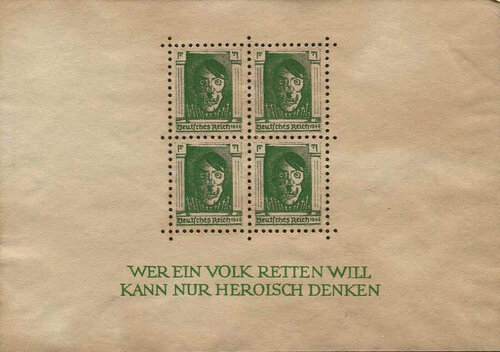
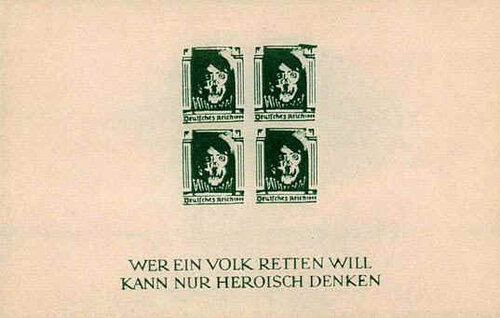
Fake green Hitler Birthday Sheets (with and without perforations)
Since some of these green Hitler sheets have been known to sell for over a thousand dollars, the fakers and forgers were quick to produce imitations to bilk unwary collectors. The fakes are of very poor quality and should not fool anyone who has studied the OSS productions.
In conclusion, the OSS produced four different postage stamps. The first two are the 6 and 12 pfennig Hitler head forgeries, the last two are the Hitler Skull stamp and the Hitler commemorative birthday stamp sheet (in both green and red).
Operations Cornflakes was designed to drop German mail sacks containing subversive material in carefully addressed envelopes inside the Reich alongside shot-up enemy trains. After the fighter-bombers stopped the train with their bombing and strafing fire, they would drop mailbags filled with propaganda letters into the wreckage. The Germans would find the bags and presume that they came from the damaged train. They would then deliver them as normal mail. The growing disruption of the German transportation system caused much mail to be misdirected and scattered about the country. Further, it was thought that any average citizen or soldier upon discovering legitimate German mail sacks in a recently bombed rail terminus or along the railroad tracks would turn them over to the postal authorities for delivery to their proper destination.
The project was initiated in January of 1945. The German mail system was investigated. German POWs who had been postal clerks were questioned on regulations, details of postal cancellations and the correct methods for packing and labeling mail sacks. Their answers were studied and cross-checked in order to obtain every detail of the system. Samples of stamps, postal cancellations, German businesses letters, and mail sacks were obtained.
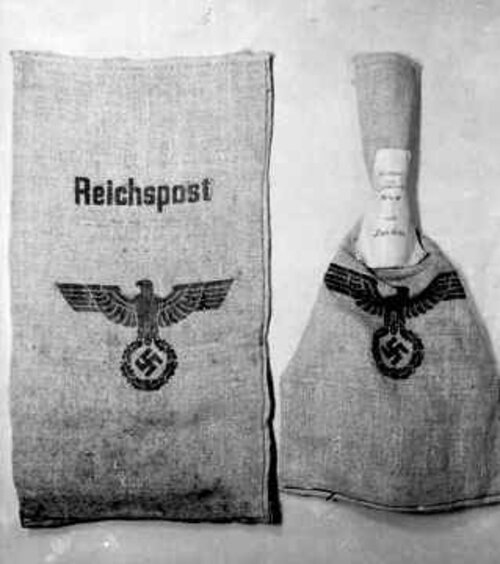
OSS Fake German Mailbags
I have a copy of a formally “Secret” report, declassified in 1990, that was the official OSS operation plan for Cornflakes. It consists of six paragraphs:
Situation: In the spring of 1945 mounting disintegration within the Nazi administrative functions present Morale Operations Rome with an unrivalled chance to infiltrate MO printed material through the exploitation of the tottering German postal system.
Objective: To weaken even further the will of the Wehrmacht and civilians to continue the losing fight. To add more confusion to the already chaotic communications and transport services. To convince the German people through the dissemination of MO printed material of the existence of anti-Nazi groups in Germany, especially strong within the business and banking circles.
Implementation: Counterfeit mail packed into fake German mailbags addressed to known Germans within the Reich; the envelopes bearing the return addresses of business, banking and insurance concerns.
Operation: From 4 February 1945 to 15 April 1945, the 14th Fighter Squadron of the 15th Air Force, on 20 sorties carried 320 “German” mailbags stuffed into seven-inch smoke shell bombs. Each bag carried 300 faked letters filled with copies of Das Neue Deutschland and other MO printed material. A special detonator cap on each bomb was linked to the pilot’s control panel so that by a slight pressure of a button the detonator cap when set off shot the bag out of the bomb at ground level during strafing missions over railroad stations and marshaling yards. The bombs remained on the plane and were later jettisoned many miles away from the original scene of the target, leaving no telltale traces of an otherwise “white” drop.
Equipment: Paper stocks; copies of MO printed propaganda; counterfeit plates for making 6 and 12 pfg. stamps and burlap bags.
Personnel: Rome: 3 officers, 5 enlisted men and 5 civilians. Bari: 2 officers, 4 enlisted men and 2 civilians. Pilots of the 14th Squadron, 15th Air Force.
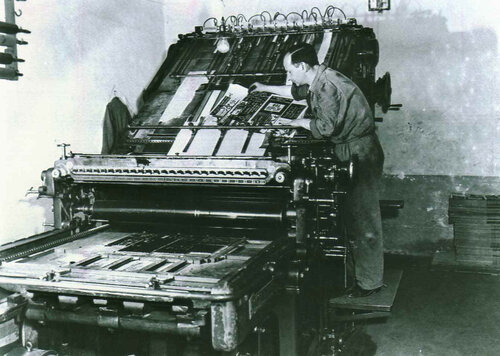
OSS Agent in the Rome Printing Plant inspects propaganda material
The Stabilimento Ariside Staderini Print Shop in Rome was the OSS Plant where the forged stamps and envelopes were manufactured. Mail sacks and sack labels were reproduced. The 15th Army Air Force was tasked with the responsibility of delivering the "mail." They were already dropping propaganda leaflets and material to partisans behind the German lines. Special bombs were designed with the capacity to carry several mailbags; each stuffed with about 800 letters. The bombs were programmed to explode about fifty feet above the target, thus allowing the released mail sacks to reach the target undamaged.
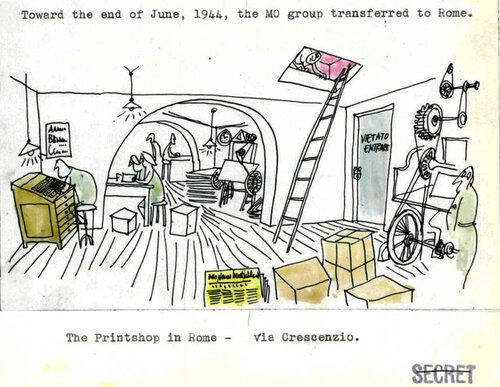
Artist Saul Steinberg’s drawing of the OSS Morale Operations Leaflet Packing room, from “Collection of Cartoons Produced by MO Artist Lt. (jg) Saul Steinberg.” NARA, Washington, DC, RG226, E99, Box 40, folder 6.
There are numerous declassified OSS documents that mention Cornflakes. An OSS progress report dated 28 March 1945 states that Morale Operations Detachment Six was established to carry out Cornflakes and Pig Iron operations where liaison with the 15th Air Force was required. The initial detachment was made up of Second Lieutenant Marcel Robich, Technical Sergeant Alfio D’Urso, and Sergeant Nicos Los.
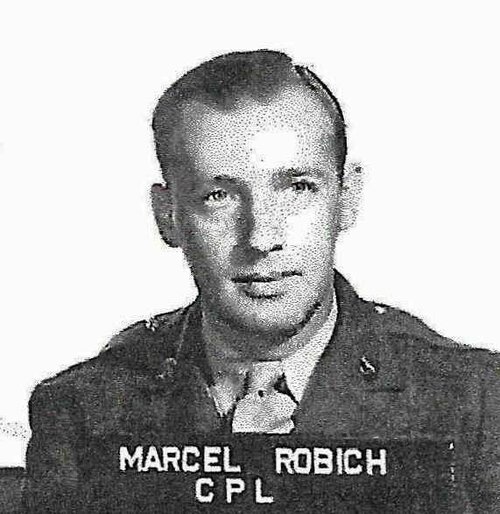
Robich’s ID Card Photo as a Corporal
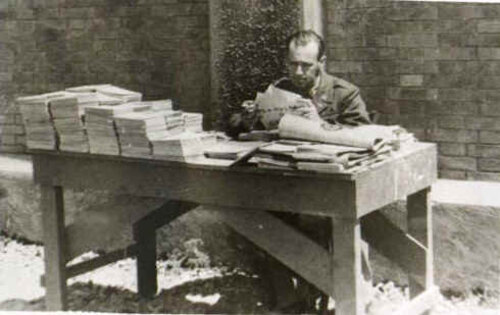
2LT Robich checks the OSS Material sent from Rome to Foggia for Dissemination
We know some of 2LT Marcel Robich’s military history. He was a successful businessman in civilian life and joined the Army on 18 April 1942 as an enlisted soldier and was assigned to the 34th Bomb Group at Bolling Air Force Base. He was assigned to the OSS in November 1943, and promoted to Sergeant in December, 1943. He served with the OSS in Europe from February 1944 to May 1945. His record in the field was so superior that he was given a direct commission. He spoke Serbo-Croatian and other Balkan dialects as well as German and French and performed duties usually done by an officer. He needed a commission to be on equal footing with other Allied officers. He made his mark in Italy where he managed the Moral Operations section’s very complicated operations with the Air Force at Foggia. Although the word is never used, this would appear to be the Cornflakes operation. He was rated superior in motivation, stability, ability to work with others and leadership by Eugene Warner, Chief of European and Mediterranean Moral Operation. In July 1945, Robich was recommended for assignment to Germany for the collection of intelligence on foreign propaganda activities. Curiously, the Communists were not the target; militaristic and pro-Nazi movements were. No more is known of his exploits.
Eight Italians soldiers were assigned security and two Italian civilians were hired for manual work. The report goes on to mention an attack on a 15-car passenger train on 16 March with 13 bags of Cornflakes mail dropped, and a 19 March attack on a “diesel electric locomotive” with 16 mailbags dropped from an altitude of 50 feet. The document states that 16 more mailbags are ready at the 14th Fighter Squadron and await “cancellation and destination tags” from Rome. Two truckloads of Das Neue Deutschland were ready to be placed in bombs and as soon as approval was granted a bombardment group would be requested for the mission.
Note: “Pig Iron” was one of the first operations where the OSS dropped leaflets over Germany. Through Pig Iron, more than 10 million miniature editions of Das Neue Deutschland were dropped on the German homeland.
Another interesting document is a 27 April 1945 request by First Lieutenant Robert Allen of Morale Operations to Rome for one bomb fully packed with Cornflakes material (less explosives). There is no mention of exactly why the bomb is needed.
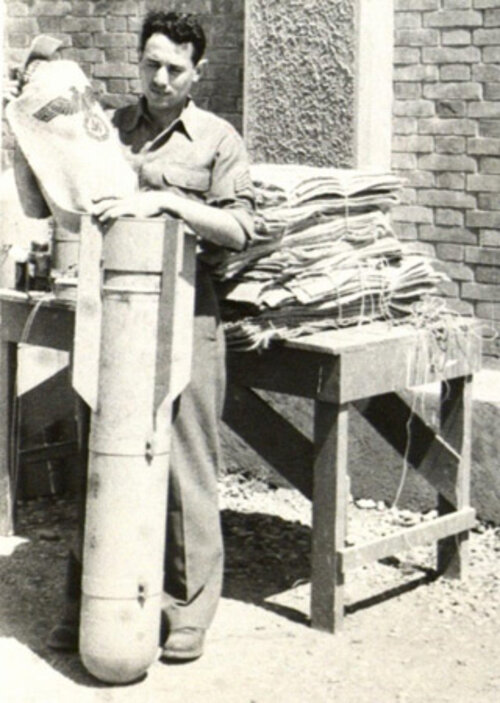
Sergeant Nick Los, winner of the Legion of Merit for work behind the lines in Greece loads a leaflet bomb with a fake German mailbag. Notice the pile of empty mailbags behind the agent
Patrick K. O’Donnell tells us about Cornflakes in Operatives, Spies and Saboteurs, Simon and Schuster, NY, 2004. He mentions that George Piday was an OSS Moral Operations agent first assigned to Bari where he took part in rumor operations against Hungary. Fake mailbags filled with subversive literature had been prepared and dropped on Hungary. He was then assigned to take part in Operation Cornflakes:
I was called back to Bari to work on the German mailbag. The envelopes were addressed in Siena, stuffed and sealed in Rome; we in Bari did the routing and Canceling. After much work and experimenting with the Air Force we had the whole operation running smoothly.
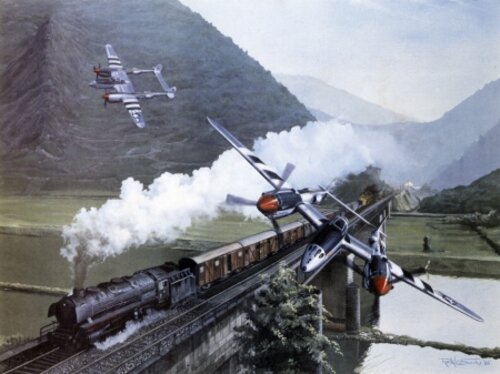
Artist rendering of P-38 from the 14th Fighter Squadron attacking a train
The 14th Fighter Squadron of the 15th Air Force was given responsibility for the operation. The technique employed by the group was to find an enemy train moving north from southern Austria, preferably with a mail car attached. The group would then attack the train, usually destroying two or more of the cars and halting the train. In the confusion, the mail sacks would be dropped around the train to be found in the debris.
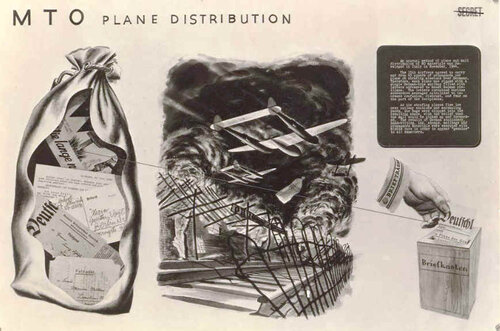
An OSS Description of the Operation from their Archives
I recognize all of the OSS leaflets in the mailbag. At the top I see one of the Wie lange noch [“How much longer?”] leaflets. Below is an OSS propaganda postcard card entitled Hitler liegt im Sterben [Hitler is on his deathbed”], an addressed OSS postcard addressed to Herrn Günther Vogt, a copy of Das Neue Deutschland in the counterfeit OSS wrapper, and a folded field post letter addressed to Frau Müller. The text on the description is:
An unusual method of plane and mail distribution of MO materials was developed in Italy in November, 1944.
The 15th Airforce agreed to carry and drop 60 pounds of propaganda per plane on strafing missions over Germany. Therefore, each plane was rigged with a single German-type mailbag filled with letters addressed to known German civilians. The letters contained various subversive messages calculated to increase confusion, distrust, and fear on the part of the recipients.
As the strafing planes flew low over the railway stations and marshaling yards, the bags were dropped into the resulting chaos with the belief that the mail would be picked up and forwarded. The details of German stationery, hand-writing, ink, stamps, mailbags and propaganda materials were executed with minute care in order to appear “genuine” to all examiners.
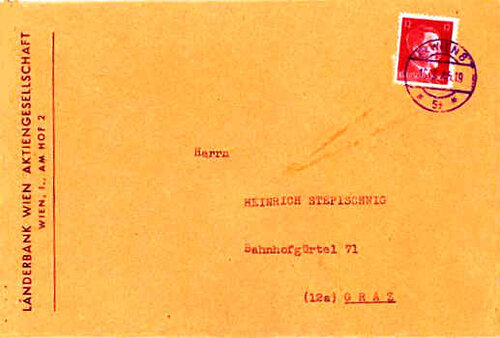
A forged Cornflakes Envelope and Stamp from the OSS Archives
The above commercial envelope found in the OSS Archives bears a forged 12 pfennig Hitler stamp. It is addressed to Herrn Heinrich Stepischnig, Bahnhofgurtel 71, (12a) GRAZ. The letter bears the return address of Landerbank Wien Artiengesellschaft, [“State bank Vienna Stock Corporation”]. Notice that the card from the OSS Archives at the top of this story says that the OSS wanted the German people to believe that there was a powerful underground in the banking circles. This card from a bank with anti-Nazi propaganda inside would play into that concept.
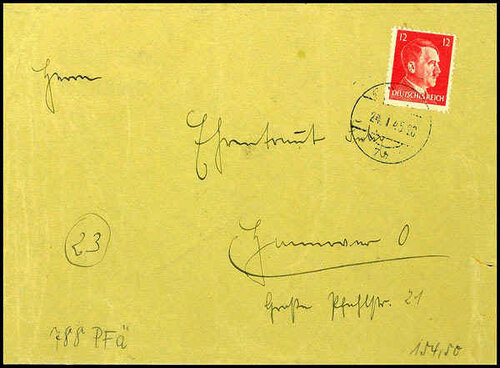
An envelope that originated from a mail bag dropped at Ruhsdorf in Bavaria
The first mission was on 5 February 1945. A train on its way to Linz in Austria was attacked. Eight mail bags, each carrying 800 letters were dropped on the target. The destination for the mail coincided with the towns along the route of the target train. In all, Army Air Force reports of ten operations, carried out between 5 February and 31 March 1945 report that trains were attacked 12 miles west of Amstellen, four miles southeast of Ybbe, 40 miles west of Vienna, and five miles southwest of Gmund. Further attacks took place 40 miles southwest of Pilsen, 10 miles northeast of Regensburg, in the vicinity of Gmund, in the vicinity of St. Poelten, near Munich, and in the vicinity of Ried. The total number of train cars destroyed in the ten raids is unknown, although it was thought that over fifty were severely damaged. The number of mailbags dropped over the targets was 88, while another four were lost in trees and wooded areas. In all, more than 50,000 pieces of mail containing subversive literature were taken into Germany.
Later official U.S. Army Air Force data indicates that there were further missions in April, the last one on 16 April. The final official total for Cornflakes is 20 missions, 320 fake German mail bags, each containing 300 letters for a total of 96,000 pieces of propaganda mail. I should note that looking through several dozen official OSS documents the number of envelopes in a mailbag is listed as 300, 400 and 800. It could be that there is some confusion between the Hungarian mailbags and the German mailbags, there was more than one size of German mailbag, or the envelopes were simply stuffed differently on different missions. As a result, the numbers we give here are all estimates.
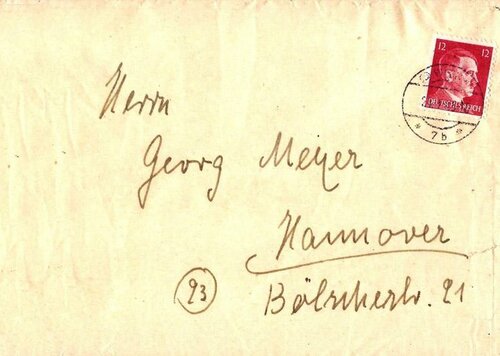
A Forged OSS Envelope to Georg Meyer of Hannover
What is interesting about these forged envelopes is that there were just a limited number of people that addressed them. After a while you get to recognize the handwriting. The cover above was sent to me by a reader who wanted to be sure it was genuine. He was worried because:
It has a Vienna cancel dated 24 January 1945 that would be earlier than the first Cornflakes mission on 5 February 1945. The return address on the back looks like an individual, not a business.
Having seen probably over 100 such covers in the past 60 years I recognized the handwriting and even thought I might recognize the address. I asked the propaganda specialist Wolfgang Baldus if he recognized it too and he did. He remembered that this particular writer used to put a handwritten sender´s address on the reverses of his covers. The early Vienna cancellation of 24 January 1945 is well known and was used for the 5 February Cornflakes mission. There are about 150 covers originating from this drop (near Ruhstorf) with this cancellation. The predating is normal because the envelopes had to appear to be collected from various post offices or letter boxes before being cancelled and put on the mail train for distribution.
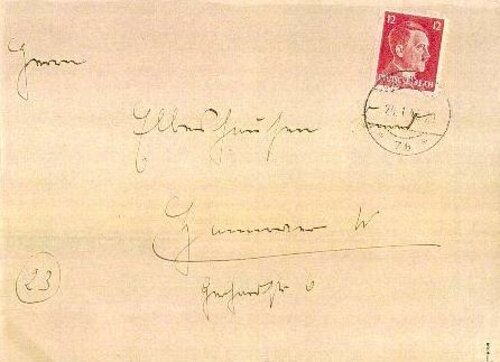
Another example of an "Operations Cornflakes" envelope
A special staff in Rome prepared the envelopes used for the project. More than two million names and addresses were gleaned from German telephone books provided the OSS Research and Analysis staff. A staff of typists was engaged to address the envelopes, producing more than 15,000 envelopes a week. Other envelopes were hand-addressed by agents of the Morale Operations unit in order to provide a plausible mixture of mail.
The forged OSS cancels on the envelopes that I have personally seen are Wien (Vienna), Hannover and Stuttgart. The dates on the cancels range from 24 January 1945 to 9 April 1945. There is some evidence that indicates that some earlier mailbag drops occurred, and they could have been pre-Cornflakes, test flights, or simply not listed in official documents. In addition there was the very first use of a forged machine cancellation:
BERLIN W8 / 22 4 45 // Preussische / Staatsbank / (Seehandlung) //* 012 / Deutsche Reichspost.
Note that the date on the meter is 22 April, later than the last reported mission. It would appear that the meter was prepared in advance and for some reason, perhaps weather or the movement of the American lines, the mission was either cancelled or never recorded.
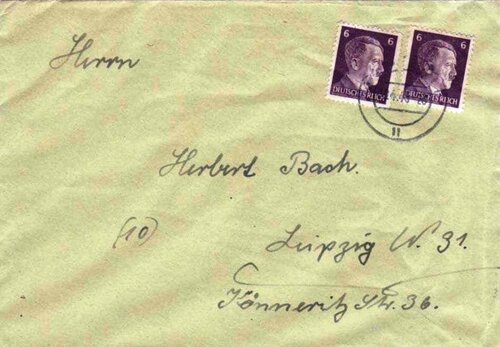
A Cornflakes cover with two 6 Pfennig forgeries
As you can see from the above samples, most of the Cornflakes envelopes bear a 12 pfennig stamp. In this case, two 6 pfennig stamps make up the 12 pfennig fee. These are a bit rarer that the 12 pfennig covers. This counterfeit cover has a fake cancel that is: Hanover 1, - 09. 4. 45.” It is addressed to Herbert Bach in Leipzig.
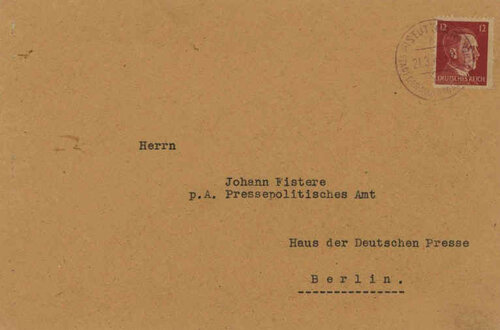
The John Fistere Cornflakes Envelope
This cover is addressed to “Johahn Fistere” who was chief of Morale Operations in Bari. The address is: Per address available at the House of the German Press. It is the only one with a Stuttgart cancellation of 21 March 1945. It could have been an “inside” OSS joke or more likely it was a file copy not meant to be airdropped, but instead meant to be filed as an example of what the OSS could produce.
My good friend and excellent philatelic research Wolfgang Baldus did a study of the various Cornflakes envelopes and sent me this report:
I have pictures of about 100 Cornflakes covers and was just sorting them according to their cancellations to see which ones are the most common ones. The covers seem to have been found by British researcher Lee Richards in OSS files. I have seen only four typewritten covers (one is the “Fistere” cover above) and believe that they were not made to be dropped but to be filed as sample covers. 95% of the covers I have seen bear only three cancellations: Vienna: 24 Jan 45, Vienna: 15 Feb 45, and Hannover: 9 Apr 45. The interesting thing is that without exception: All covers with Hannover cancellations (40 covers) are addressed to Leipzig and Dresden; All covers with Vienna 24 Jan 45 cancellations (33 covers) are addressed to Hannover; and all “Cassenverein” covers are cancelled Vienna 15 Feb 45 and are addressed to Cologne (7 covers). Comparing the handwritings it seems that only two or three writers addressed the covers that got a common cancellation.
The Torrey and Avery report states:
During the first four months of 1945, 21 people in the OSS Morale Operations unit attached to the Mediterranean Theater of Operations were occupied in carrying out this scheme, labeled "Operation Cornflakes." Their task was to exploit the disintegration of German administrative functions in the last weeks of the war by infiltrating printed propaganda--principally the "underground" newspaper Das Neue Deutschland--into the Reichspost. Their objectives were to weaken further the will of the German people to fight, to increase confusion in the communication and transport services, and to convince the German people that there was an anti-Nazi underground in Germany especially active in business and banking circles.
Much of the mail bore business return addresses, among the better known "The Prussian State Bank," "The International Corporation for Transport and Traffic Affairs," "The New Deutschebank," "The Credit Reform Company," and the very important "Wiener Giro - und Cassenverein."
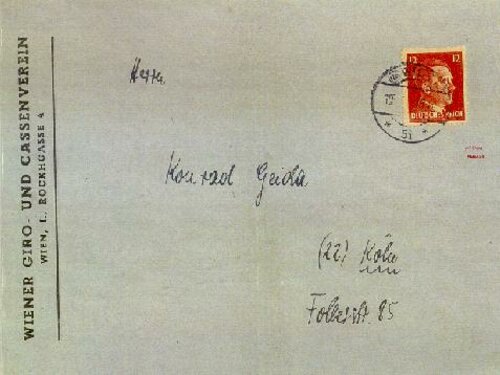
The Cassenverein Cover
The "Cassenverein" cover became famous because it was allegedly the first of the OSS items to be identified as a forgery by the German postal authorities.
According to a story that has been told since the end of WWII, at the conclusion of the 16 March 1945 raid on the train near St. Poelten, German security police found the OSS mailbags. The bags were opened and mail addressed to citizens in the Cologne area was discovered. As the mail was about to be forwarded, a sharp-eyed postal clerk noticed that the return address on the envelopes was "Wiener Giro-und Cassenverein." The correct spelling of the final word should have read "Kassenverein." For the want of a "K" the game was lost. The Nazis became suspicious, the envelopes were opened and the propaganda placed inside was discovered. The story first appeared in an article titled Weekly Philatelic Gossip by Paul Weber in 1950. I first read it in L. N. & M Williams booklet Forged Stamps of Two World Wars written in 1954. I never had reason to doubt the story.
I never heard anyone refute this tale until 2019 when the German researcher Wolfgang Baldus forwarded me a number of clippings from wartime German newspapers. He told me:
The clippings tell about the merging of the Cassenverein into the Reichsbank in 1943. The clippings are important because they are from wartime and prove the way the word was spelled in these years. It seems both spellings were used without distinction. You can find many other newspaper sources with both Kassenverein and Cassenverein used in newspaper articles of earlier years.
Corey Ford mentioned this campaign briefly in the book Donovan of the OSS, Little Brown, Boston, 1970. He says:
Another ingenious method exploited the disruption of the German postal system due to Allied bombing of the railways. Fake German mailbags were prepared and filled with subversive letters stamped, postmarked, and inscribed with real addresses from local directories. These bags were dropped by the Fifteenth Air Force in strafing missions over marshaling yards and railway stations, in the hope that they would be picked up as stray mail pouches lost from wrecked railroad cars, and would be sent on by regular mail. There is no evidence that this device was ever detected.
Ford could be wrong, since as we have shown, on at least one occasion it was reported, perhaps in error, that envelopes in the bags were detected and identified.
Most of the envelopes and their propaganda were destroyed during the war. A few that have survived are collector's items today. German security officials have stated that 97 percent of all the forgeries sent into the Third Reich were located and destroyed.
Of course, the OSS did collect and file vast amounts of their propaganda material and there is a large amount of samples and documents in the United States National Archives. In 2010, I was called by an Archives investigator who told me that three pages that had previously contained nine Cornflakes OSS envelopes were now bare. The envelopes had apparently been stolen by a researcher who had visited the Archives. I told him that if he had photocopies of the pages we could probably use the addresses to search for the envelopes through various Third Reich and propaganda collector's groups. No photographs had been taken. There is no record of what was on the file pages; just some blank sheets with discolored areas where the envelopes had been mounted, and rust marks where they had been stapled to the paper. With no record of what the items looked like I informed the investigator that there was absolutely no way to find those missing envelopes.
Although there were different combinations of propaganda material inside of the airdropped Cornflakes envelopes, we do have some examples of envelopes that still contain their original contents.
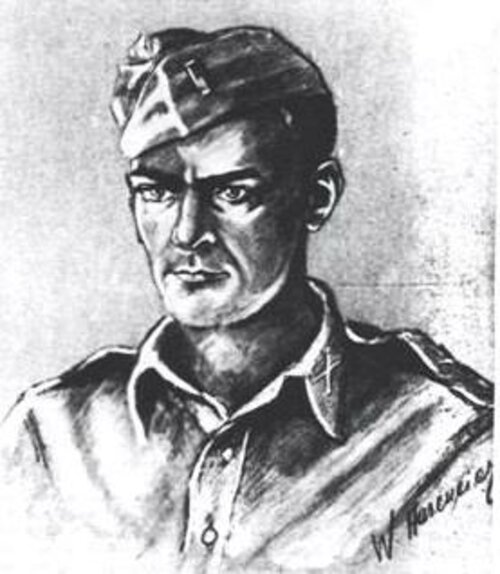
First Lieutenant Jack Daniels as sketched by German prisoner-of-War Willi Haseneier*
* Willi Haseneier was captured 4 June 1944. An artist and graduate of the Düsseldorf Art Academy, he was used by his OSS handlers to forge identity papers, passes, credentials and signatures. At the end of the war he worked for the Allies producing visual aids for the Nurnberg trials. He later went on to Hollywood where he became a successful artist producing posters and advertisements for the Motion Picture industry. In 2005 he wrote to me to and informed me that Hollywood was considering a motion picture about his life.
Two such envelopes were saved by Jack Daniels of Savannah, Georgia. The present owner of the envelopes was told that Daniels (an old friend of the family who presented him the envelopes as a gift about 1960) was one of the pilots that dropped the mail bags onto the wrecked trains. In fact, we know that 1LT Jack Daniels was an OSS agent assigned to the Morale Operations (MO) Branch, Bari, who worked on both Operation Cornflakes and Operation Sauerkraut in late 1944 and early 1945. In the latter operation he was involved in sending volunteer German prisoners-of-war behind enemy lines on spying and propaganda missions. By March 1945 Daniels was Chief of OSS Morale Operations, Bari. Daniels is mentioned in The Story of Cornflakes, Pig Iron and Sheet Iron:
The operational side of the project, meanwhile, had been placed under the direction of Lt. Jack Daniels, located at that time with Company B, in Bari. Contact was established with the 15th Air Force and a fighter group was designated to carry out the mission.
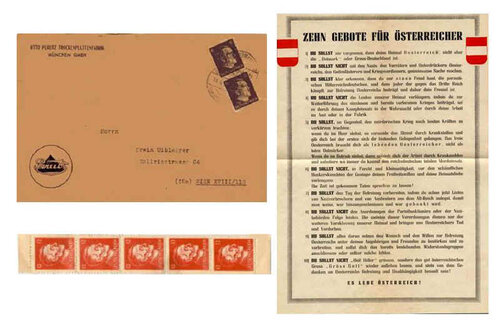
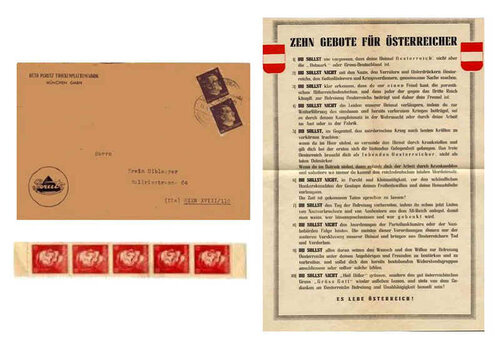
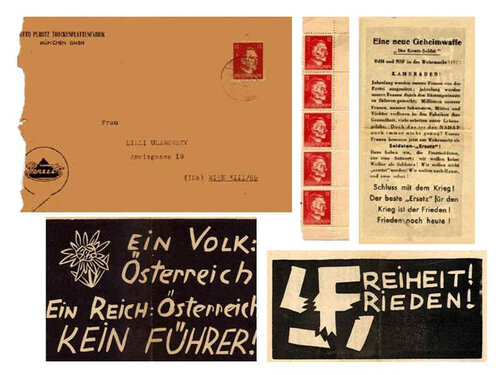
Two OSS Envelopes with Contents
Both envelopes have the same return address and logo and are dated 11.4.45:
Otto Perutz Trockenplattenfabrik Munchen GMBH
One envelope is stamped with two 6-pfennig OSS forged Hitler-head violet stamps and addressed to Herrn Erwin Uiblagger, Wallrisstrasse 64, (12a) WIEN (Vienna) XVIII/110. The second envelope bears one 12-pfennig OSS forged Hitler-head red stamp and is addressed to Frau LILLI ULANOWSKY, Ameisgasse 19, (12a) WIEN XIII/89.
The envelope with the two 6-pfennig stamps contains a strip of five 12 pfennig Hitler skull stamps and a printed leaflet entitled Zehn Gebote für Osterreicher ("Ten Commandments for Austrians"). The text of the leaflet is:
Ten Commandments for Austrians
1) YOU SHALL never forget that your home is Austria and not "Ostmark" or Pan-Germany. ["Ostmark" was the name of Austria within the Third Reich].
2)YOU SHALL NOT make common cause with the Nazis, the traitors and oppressors of Austria, the blasphemers and war profiteers.
3) YOU SHALL clearly be aware that you have only one enemy, the parasitic Germans of Hitler’s Reich, and that everyone who fights against the Third Reich contributes to the liberation of Austria and is, therefore, your friend.
4) YOU SHALL NOT prolong the suffering of our home by contributing to the continuation of the senseless war which is already lost, be it through your combat service in the Wehrmacht or through your work in an office or a factory.
5) YOU SHALL, contrarily, strive for shortening the murderous war with all your strength: When you are in the army, avoid active service by simulating illness and surrender at the first opportunity. The free Austria needs you as a living Austrian, not as a dead "Ostmärker". When you are working, then escape work by letting your boss know that you are sick and sabotage wherever you can the total murderous mission of the Germans.
6) YOU SHALL NOT deny your wish for freedom and your love to your home in fear and faintheartedness of the shameful hangman’s assistants of the Gestapo. Time has come to proceed to action!
7) YOU SHALL prepare the day of the liberation by starting right now to write down the names of Nazi criminals and exploiters from the Old Reich, to make clear who will be fired and who will be hanged.
8) YOU SHALL NOT obey the orders of party functionaries or Nazi authorities. The majority of these orders just lead to a further enslavement of our homeland and bring death and misery to us Austrians.
9) YOU SHALL do everything you can to strengthen and disseminate the wish and will for the liberation of Austria among your relatives and friends, and you shall join the existing resistance groups or form such ones yourself.
10) YOU SHALL NOT say "Heil Hitler" but revive the good old Austrian greeting "Grüss Gott" ["God be greeted"], and you shall always think of Austria’s liberation and independence!
LONG LIVE AUSTRIA!
We have some numbers for the amount of these leaflets prepared by the OSS. We know that from 15 July 1944 to 15 May 1945 the OSS printed a total of 82,700 of these leaflets that were forwarded to various stations.
The envelope with the one stamp contains a strip of five 12 pfennig Hitler skull stamps and two smaller leaflets. The first reads; Freiheit! Frieden! ("Freedom! Peace!") with the "F" being formed by a broken swastika. Text on the back of this leaflet is:
A New Secret Weapon "The Substitute Soldier" BdM and NSF in the Wehrmacht!!!!!!
[BdM is the Bund deutscher Mädchen or "Association of German Girls." We are not sure about "NSF" but believe it to be Nationalsozialistischer Frauenbund or "National Socialist Women’s League."].
Comrades!
For years our women have been used by the party; for years our women have been enslaved by the armaments industry; millions of our women, our sisters, mothers and daughters lose their health in the factories, many are working in danger of life. However, this is still not enough for the NSDAP! Our women now join the army as Soldier’s substitutes!
We soldiers at the front have only one answer to that: We do not want women as soldiers! We do not want to be "replaced" We want to go home, immediately!
Finish the war!
The best "substitute" of war is peace"!
Peace today!
The second reads; Ein Volk: Osterreich ein Reich: Osterreich Kein Führer! ("One people: Austria; one Empire: Austria, No Führer!").
This would appear to be a parody of the German Nazi Party slogan Ein Volk, ein Reich, ein Führer ("One people, one Empire, one Leader"). The Story of Cornflakes adds:
Since "Das Neue Deutschland" embraced all of MO's propaganda themes and contained them all in the smallest space, the vast majority of the envelopes were stuffed with the newspaper. In some envelopes, which were addressed to Austrian cities, the "Ten Commandments for Austrians" was included, also Austrian "underground" newspapers such as "Der Osterreicher." Stickers and stamps made up the rest of the enclosures.
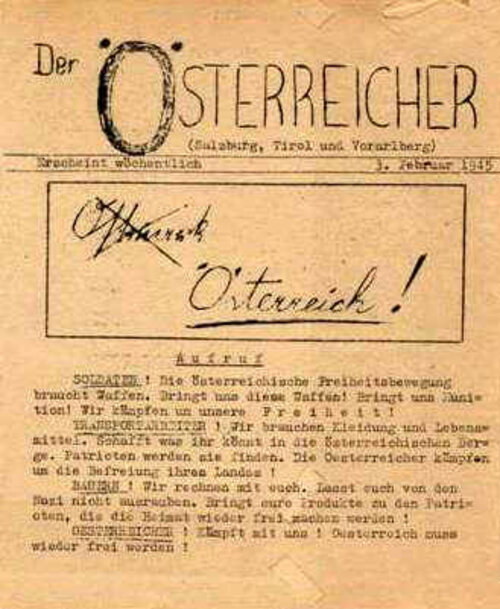
Der Osterreicher of 3 February 1945
Note the crudeness of this OSS newspaper to the Austrians. It pretends to be a product of an Austrian underground movement and thus was made to appear to be the kind of product that they would produce on cheap paper with a hidden mimeograph machine. Since the paper is supposed to be from an anti-Nazi underground, notice that the first paragraph says:
Soldiers! The Austrian freedom movement needs weapons. Bring us these weapons! Bring us ammunition! We fight for our freedom!
In 2015, a small collection of Cornflakes leaflets was offered for sale and the Ten Commandments for Austrians leaflet was included. The collection was formed by Corporal Arthur Baker whose discharge states:
Radio Operator – Served with the Office of Strategic Service for six months in Italy. Operated and maintained high speed radio equipment used code. Received and sent international Morse Code. Set up and maintained radio communications.
It appears that the corporal had nothing to do with leaflets, but like all Americans he was an avid souvenir collector and brought home about 30 of the Rome OSS Propaganda leaflets. The leaflet lot eventually sold for $396 US, or a bit over $13 each.
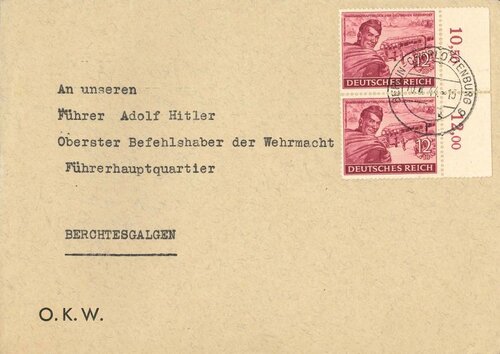
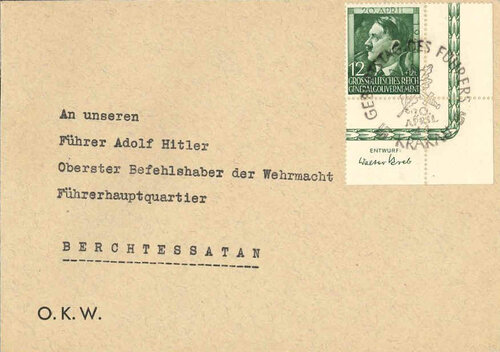
Two Mysterious Cornflakes Envelopes Courtesy of Richard Thorner
We know very little about these envelopes addressed to Adolf Hitler except that they were found in material that passed through the hands of OSS agents Arthur Schuhl and Gerry Mayer. The envelopes were apparently forged by Schuhl in Bern and later used to produce these parodies. There is no sign of American interference of any kind except in the spelling of the word Berchtesgaden, Hitler’s “Eagles Nest.” On both envelopes that address of Adolf Hitler has been changed to attack the Führer.
Note that the first envelope was sent to Berchtesgalgen. The German word Galgen is “gallows” in English. The second cover is addressed to Berchtessatan, and “Satan” is universal for evil. It is clear that with those addresses the envelopes never passed through the German mails. The printed “O.K.W.” is suspicious. The Oberkommando der Wehrmacht would not use such an envelope and never use the wording “To our Führer…”. I spoke to Wolfgang Baldus, the propaganda specialist about these covers and he thinks they might have been demonstration covers (such as those British forger Ellic Howe prepared with his British Hitler forgeries). Might these two been fancy propaganda covers made by Hansi or Schuhl for presentation to an OSS superior?
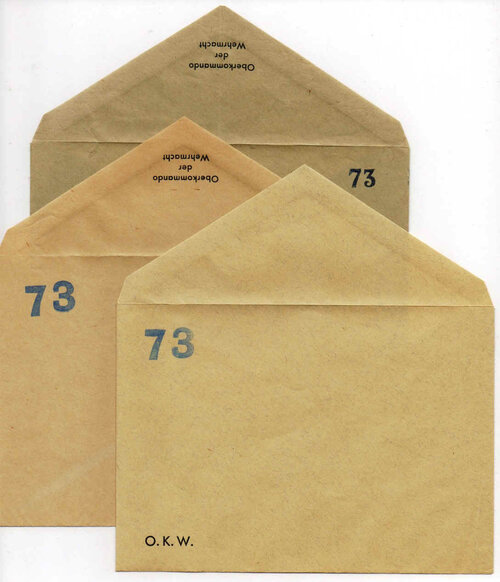
The Fake German Military Envelopes found in OSS Files
In 2008, I was contacted by the daughter of Erwin Uiblagger who was trying to understand why her father’s name appeared on a forged Cornflakes envelope. I explained that the name might have been found in a phone book, German military or civilian files, or even volunteered by a captured comrade. The daughter said that his father had been captured on the Russian front in 1941 and later was killed or died in captivity. She thought that the name and address might have been found in his military identity papers. We will never know how or why the name was placed on an envelope, but the individual did exist and we now know his fate.
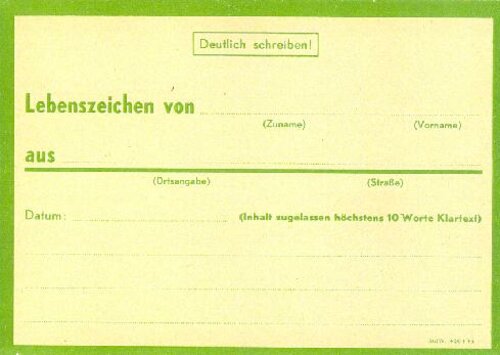
Genuine "SIGN OF LIFE" Card
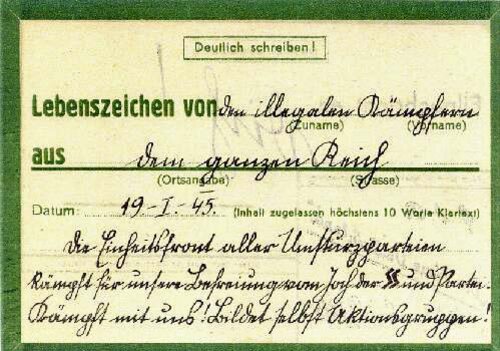
OSS Forgery of "SIGN OF LIFE" Card
Some of the propaganda documents placed inside the OSS envelopes are worth mentioning. For instance, we find a reproduction of the official German form used to notify relatives of survivors of allied bombings. In 1943, the German Reichspost released special postcards that allowed victims of bomb attacks to send a short message to their relatives. Three versions differing in color and design were printed. They are inscribed "Lebenszeichen von" (Sign of life from) on one side, and "Eilnachricht an" (express message to) on the back. All have a broad color frame around the margins. Red cards were for private addressees, green cards for soldiers with field post numbers. Violet cards were used by the Reichspost to check the postal addresses of people living in so-called "Luftnotgebieten" (Air raid zones). This form, sometimes called Sign of Life, might be sent to a serviceman from Berlin or Cologne to inform him that his parents were alive and well after a severe raid. These forms usually passed through the German post at no cost to the sender. They normally bore no cancellation, although they were sometimes censored. The OSS forged the green version of the sign-of-life card. The forgery is inscribed in German in carefully handwritten Gothic script. On the address side where the genuine card says "Express to" the OSS added the word "you!" At the lower left, they added the text "F.D.R," short for "Fur die Redakation," ("For the editor"). Beneath those words are Text, which translates to, "The New Germany, Action Committee." The message side bears a longer propaganda text, "Sign of life from - The Illegal fighters – in all the Reich." The card is dated "19-1-45." Text beneath is, "The United Front of all revolutionary parties fights for our liberation from the yoke of the SS and the Party. Join us in the struggle! Form your own action groups!"
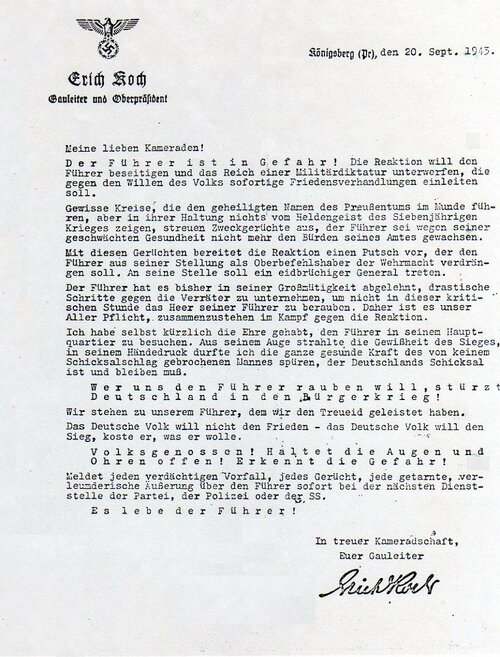
The Erich Koch Letter
The OSS prepared an alleged letter from Nazi Gauleiter (Regional Party Leader) Erich Koch that mentions Hitler’s “weakened health,” a subtle hint that the Fuehrer was less than 100%. It mentions the generals wanting to make peace and is almost a prophecy of the plot to kill Hitler that will take place in the future. It attempts to make civilians distrustful of their military leaders, and soldiers confused about the alleged conflict between the Fuehrer and their own generals. The text is:
Erich Koch Konigsberg (East Prussia) Gauleiter for East Prussia 20 September 1943
My Dear Comrades,
The Fuehrer is in danger. The reactionaries want to do away with our Fuehrer and subject the Reich to a military dictatorship which will against the will of the people immediately initiate peace negotiations.
Certain parties, using the beloved name of Prussianism, but showing in their attitude none of the heroic spirit of the Seven-Year War, spread rumors that the Fuehrer, because of his weakened health is no longer able to carry on the burden of his office.
With these rumors, the reactionaries prepare an uprising which aims at replacing the Fuehrer in his post of Supreme Commander of the Wehrmacht. His place is to be taken by a traitorous general.
In his magnanimity, the Fuehrer has so far refused to take drastic action against the traitors so as not to deprive the army of its leaders in this critical hour. It is therefore the duty of all of us to join together in the struggle against the revolutionaries.
I recently had the honor of visiting the Fuehrer in his headquarters. His eyes radiated the certainty of victory, his handclasp expressed the healthy power of a man unbroken by the adversities of fate, a man who is, and must remain, Germany’s fate.
HE WHO WANTS TO DEPRIVE US OF OUR FUEHRER WILL THROW GERMANY INTO CIVIL WAR!
We will remain faithful to our Fuehrer in accordance with our oath. The German people do not want peace. The German people want victory, no matter what the price.
COMRADES! KEEP YOUR EYES AND EARS OPEN! RECOGNIZE THE DANGER!
Report every suspicious incidence, every rumor, and every disguised defamatory remark about our Fuehrer immediately to the nearest Party office, the police or the SS.
LONG LIVE THE FUEHRER!
In faithful comradeship
Your Gauleiter
Erich Koch
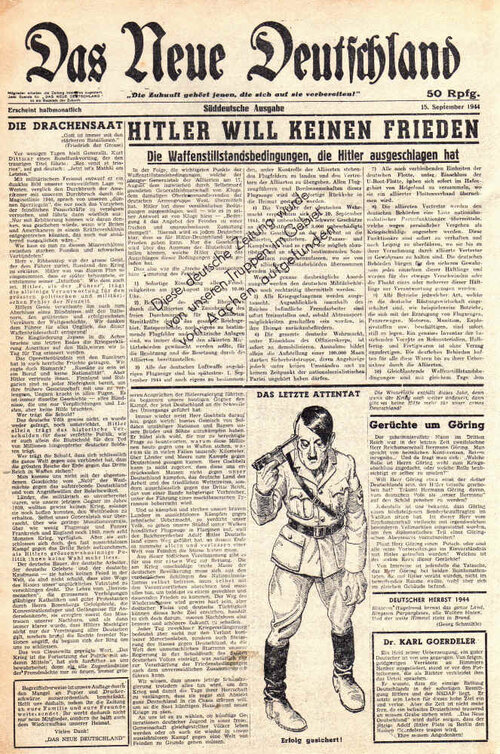
DAS NEUE DEUTSCHLAND NEWSPAPER
Das Neue Deutschland was a propaganda newspaper produced by the OSS in Rome. It embraced all of the propaganda themes and contained them in the smallest possible space. More than ten million copies of the newspaper were printed. The papers were disguised as captured editions and were given an overprint reading "This German newspaper fell into Allied hands during the occupation of Paris." It was hoped that the German public would believe that an opposition party within the Reich sponsored publication. The newspaper was first printed in a standard size. It was then reduced by photography to 10 inches by 6½ inches. One million copies a month were produced initially. Later on, the number rose to a million a week.
Eugene Warner, Chief of European and Mediterranean MO says that the first newspapers were used as stuffing or packing around explosives and other supplies in the cylindrical metal containers which were parachuted to the Maquis. Earlier burlap had been used. By discarding the burlap and using the newspapers, MO was able to greatly increase its circulation. In addition to these papers used for padding, other papers were wrapped in MO kits and these too were shipped in simultaneously. All in all, 75,000 copies were printed for the first issue and all were shipped in one form or another to MO outposts, or back of the lines, about 65,000 going into France.
Some of the titles and contents of the August 15, 1944 issue are "The Sinking Ship," an attack on Turkey and Spain for ignoring their old allies. This article accuses General Franco of Spain of treachery and recalls that it was Germany that helped put him in power. Another article, "More Gallows, More Blood," tells of the Germans murdered after the attempt on Hitler’s life. It says that the Nazi Party and Gestapo killed many innocent people and mentions 186 civilians murdered, although no names had been published. "Treason against Germany" is expose of the so-called adventurous plans of the General Staff, which had made possible further landings in France.

Das Neue Deutschland Newspaper in Military Fieldpost Mailing Wrapper Courtesy of Psywar.org
The Above photograph of the American propaganda newspaper in a mailing wrapper ready to be addressed was found by researcher Lee Richards in a 1 October 1945 review sent to the OSS Morale Operations Reports Office by Eugene Warner, Chief of European and Mediterranean MO Section.
After the German surrender in Italy, it was ascertained that troops had received copies of Das Neue Deutschland through the mails. Some of these letters resulted in investigations by German Counter-Intelligence of entire units, with courts-martial following. German prisoners reported having seen the propaganda newspapers as far north as the Baltic ports and reports a widespread knowledge of a "underground movement" named "Das Neue Deutschland" in Austria and other sections of the Third Reich. Ninety percent of those prisoners questioned believed that this underground movement was genuine.
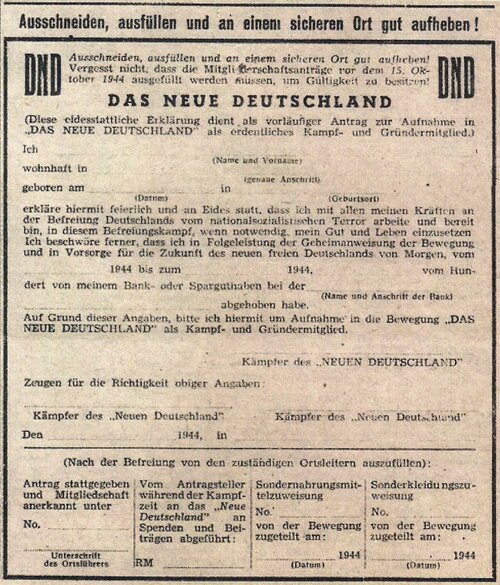
Das Neue Deutschland Membership Card Courtesy of Psywar.org
As part of the plan to make the Germans believe that there was a strong anti-Nazi underground, membership cards were printed in the 15 September 1944 newspaper.
At the end of the war, German POWs were questioned about their knowledge of the propaganda newspaper. It was found that 45% of them knew about the DND movement and 14% had actually read the newspaper.
Besides stamps, The OSS forged and parodied newspapers, stickers, postcards, lettersheets, and other documents. For instance, the Final Report of Production and Distribution, reports 94,100 postcards printed by OSS Rome between 15 July 1944, and 15 May 1945.
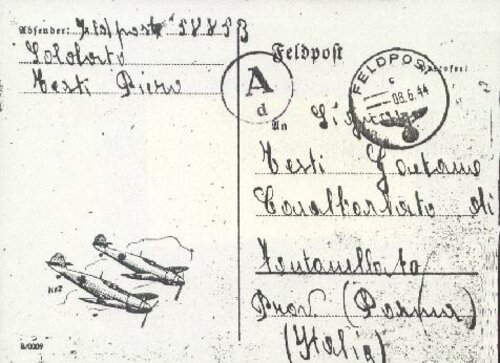
Genuine Used German Feldpost Card
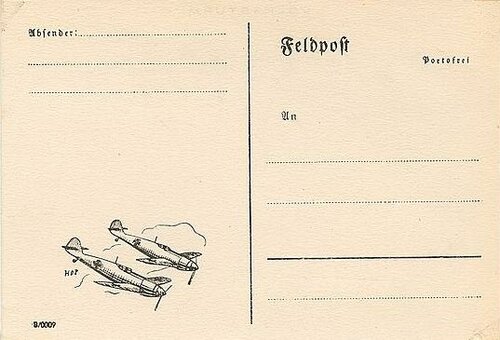
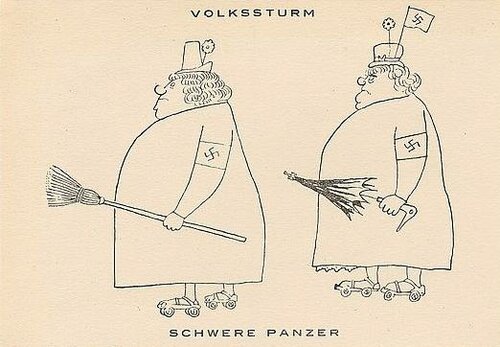
Forged Postcard
The forged postcards consist of 13 plain postcards on yellowish paper and 3 multicolored picture postcards. Many of the postcards were printed under Operation Cornflakes, but they were often disseminated behind the lines under Operation Sauerkraut, a Rome OSS project that used trustworthy German prisoners of war to carry the cards behind the lines and distribute them.
One card is a parody attacking the elderly Volkssturm called to service to protect the Reich in the last days of the war. There is no inscription on the address side of this card. The reverse features a caricature of two obese women on roller skates. Both wear armbands with a swastika, and little hats with a flower or a flag. The lady at left carries a broom as a weapon; the lady behind her has an umbrella. The inscription on top reads "Volkssturm" (People’s Resistance), and at the bottom "Schwere Panzer" (Heavy tanks). The postcard ridicules the German attempt of autumn 1944 to mobilize military power by conscripting children and elderly people. On September 25, 1944, Hitler called all male individuals between the age of 16 and 60, who did not already serve in the Wehrmacht, to arms.
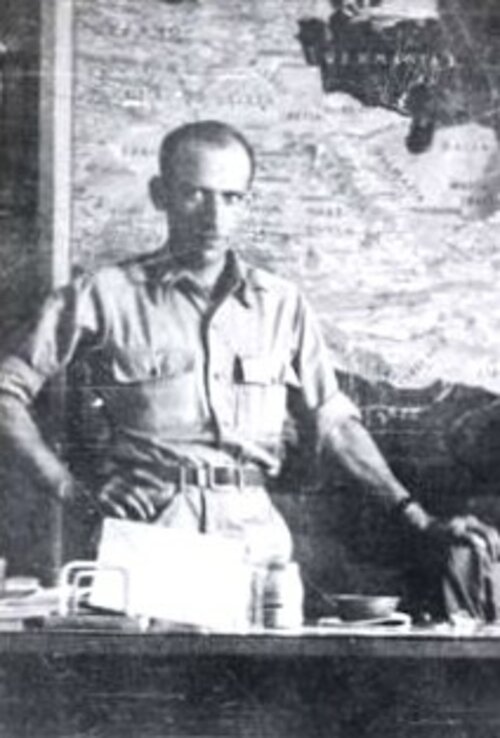
Steinberg in the Morale Operations Office, OSS, Rome published in Joel Smith, Steinberg at The New Yorker, Harry N. Abrams, 2005 © The Saul Steinberg Foundation.
One of the artists who worked in the OSS Morale Office in Rome was Saul Steinberg of The New Yorker fame. I never published his name in earlier articles, although he is mentioned in some OSS documents. Since he died in 1999, I think we can now mention his exploits. I spoke to an aging member of the old MO, Rome crew and he told me that Steinberg drew the Schwere Panzer postcard. I pointed out that in official papers such as the Semi-Monthly Report, M.O. Section, Period 15-31 July 1944 Steinberg was never given a code name or a duty. It simply said “Lt. Saul Steinberg, USNR.” He explained that Steinberg did not go behind the lines or deal in black operations so there was no need for a code name. He was a “floater” who did illustrative work as needed such as flyers, postcards and covers for song sheets allegedly from anti-Nazi organizations. As a result, he had no real duty position. Other individuals who are listed with their code names are; Eddie Zinder, Writer, Helmuth Cruchol, printer, and MSG Richard Lee, Editor.
Although Romanian by birth, Steinberg had escaped from wartime Italy in 1941. He had a diploma from the Reggio Politecnico, but under Italy’s new anti-Semitic laws he was identified as “Saul Steinberg, of the Hebrew race.” By 1942 he was working for the Office of War Information and was soon commissioned an Ensign in the Naval Reserve working for Intelligence in Washington, DC. In 1943 he was sent to Kunming, China, and by December he was in Algeria. He was next sent to North Africa and finally to the OSS in Allied-occupied Rome. In September, 1944, he was ordered back to Washington.
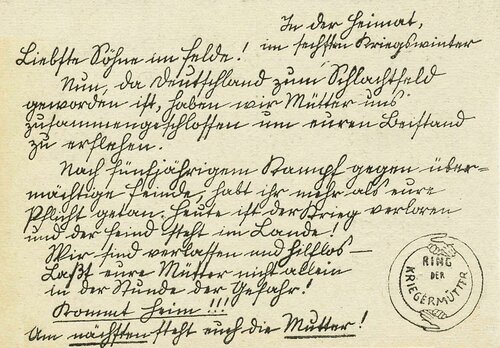
"Ring der Kriegermütter" (War Mother’s Group).
Another postcard bears an emblem that represents the seal of a fake organization created by the OSS. The circular seal is poorly drawn by hand and consists of two semi-circular forearms with joining hands on both ends. In the center are the words "Ring der Kriegermütter" (War Mother’s Group). The OSS wanted the finders to believe that there was an organized group of miserable, lonely mothers who desired their sons in the field to desert. The text is, "At home, in the sixth winter of the war. Dear sons in the field! Now that Germany has become a battlefield, we mothers have joined together to beg your assistance. After five years of struggle against overwhelming enemy power, you have done more than your duty. Today, the war is lost and the enemy is within our country! We are abandoned and helpless. Do not leave your mothers alone in the hour of danger! Come home!!! The mothers are your nearest and dearest!"
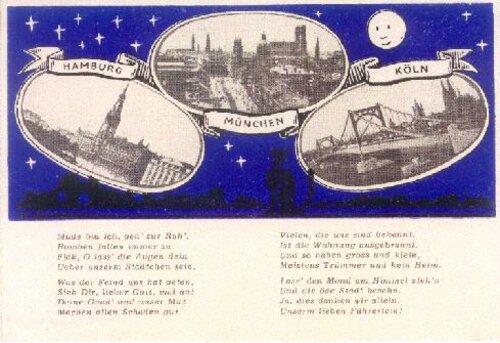
The OSS Bombed Cities Postcard
The three colored picture postcards have almost identical illustrations. They depict scenic views with oval portraits of three intact German cities against the night sky. The black silhouette of a bombed and ruined town and a howling cat are below the oval vignettes. The full moon is shining and stars are sparkling, although they have the form of burial crosses. Below the scene is a parody of a famous German lullaby. The propagandists changed the original wording and wrote about bombs and destruction to weaken the willingness of the Germans to continue the war. All three cards have the same lyrical text:
"Tired am I, I’m going to rest, the bombs continue to fall let the eyes of the anti-aircraft protect our little town.
What the enemy has done to us. Dear God, just look at it! Your grace and our courage will repair all damage.
Many that are known to us had their houses burnt, and so large and small have mostly rubble and no home.
Let the moon stand in the sky and reveal the desolate city. Yes, all this we have only you to thank our dear little Führer!"
Some of the towns depicted on these cards are Essen, Berlin, Bremen, Hamburg, Munich, and Cologne. Readers who wish to learn more about these OSS postcards and see them all illustrated and translated should read "The American Propaganda Postcards of World War II," Herbert A. Friedman, German Postal Specialist, February, 1987.
Besides stamps and postcards, the OSS also produced at least eight fake feldpost lettersheets in the German language. The Morale Operations Unit (MO) printed them in Rome in mid-1944 to early 1945. These large sheets fold into an envelope before mailing. Rome printed 287,000 lettersheets between 15 July 1944 and the end of the war. Almost all of these lettersheets claim to come from associations or groups that are in fact, nonexistent.
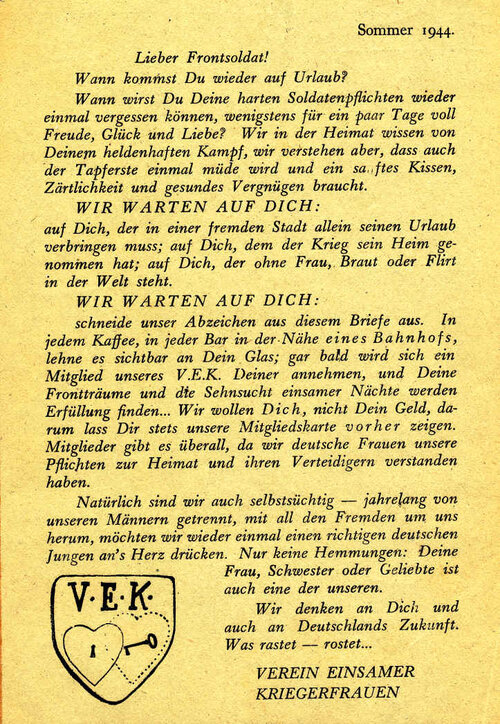
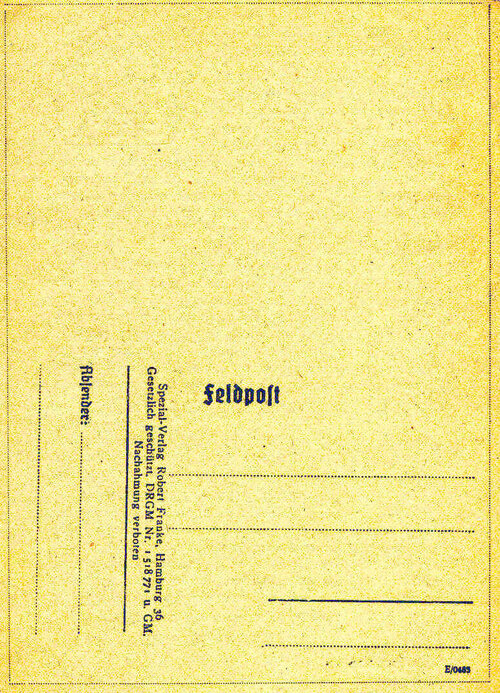
VEK Lettersheet
The OSS produced the first letter in an attempt to destroy the morale of German troops by telling them that their wives, girlfriends or sisters were having casual sex while they were fighting at the front. The letter allegedly originates from the "Verein Einsamer Kriegerfrauen," (VEK), ("Association of Lonely War Women"). The text is, "summer 1944. Dear soldier at the front! When will you have leave again? When will you be able to forget your arduous soldier’s duties for a few days of fun, happiness and love? We at home know of your heroic struggle. We understand that even the bravest tires sometimes and needs a soft pillow, tenderness and healthy enjoyment. We are waiting for you. For you who must spend your leave in a foreign town; for you whom the war has deprived of a home; for you who is alone in the world without a wife, fiancée or girl friend. We are waiting for you: Cut our symbol from this letter. In every coffee shop, in every bar near a railway station, place it on your glass so that it can be clearly seen. A member of our VEK will soon contact you. The dreams you had at the front, and the longings of your lonely nights, will be fulfilled... We want you, not your money. Therefore, you should always show our membership card (to anyone who may approach you). There are members everywhere, because we women understand our duties to the homeland and to its defenders. We are, of course, are selfish too – we have been separated from our men for many years. With all those foreigners around us, we would like once more to press a real German youth to our bosom. No inhibitions now: Your wife, sister, or lover is one of us as well. We think of you and Germany’s future. Which rests – rusts. (Use it or lose it) V.E.K. The Association of Lonely War Women". The emblem of the "VEK" is printed in the lower left corner of the letter. It is a shield with two hearts inside, one with a key, the other with a keyhole. The emblem is self-explaining. Above the hearts are the letters "V.E.K". The soldiers placed this symbol on their beer glasses. There was no such association. The OSS simply attempted to create unrest among the German soldiers as to the faithfulness of their wives, fiancées, or girlfriends at home.
In 2015 a large collection of leaflets was offered for sale and the VEK letter sheet was included. The collection was formed by Corporal Arthur Baker whose discharge states:
Radio Operator – Served with the Office of Strategic Service for six months in Italy. Operated and maintained high speed radio equipment used code. Received and sent international Morse Code. Set up and maintained radio communications.
It appears that the corporal had nothing to do with leaflets, but like all Americans he was an avid souvenir collector and brought home about 30 of the Rome OSS Propaganda leaflets.
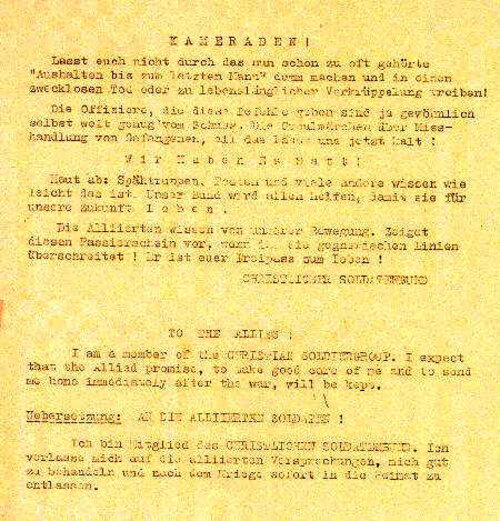
The "Christian Union" Lettersheet
Another letter is from the fake resistance group, the "Christian Soldiers Union." The text is typewritten and faded as if it were mimeographed under clandestine conditions. The text is, "Comrades! Don’t let them take advantage of you with that old slogan ‘Hold out to the last man,’ and pointlessly be killed, or crippled for the rest of your life! The officers who give these orders are usually far from the shooting. All the grisly tales of mistreatment of prisoners leave us cold now. WE HAVE HAD ENOUGH! Give up: scouts, sentries, and many others know how easy it is. Our group will help everyone so that they can live for our future. The Allies know about our movement. Give them this pass when you cross the enemy’s lines! It is your pass to life! Christian Soldiers Union." A surrender pass is printed below the text in German and English. The English text is, "To the Allies! I am a member of the Christian Soldier’s Union. I believe in the Allied promise to treat me well and to send me home as soon as the war is over.
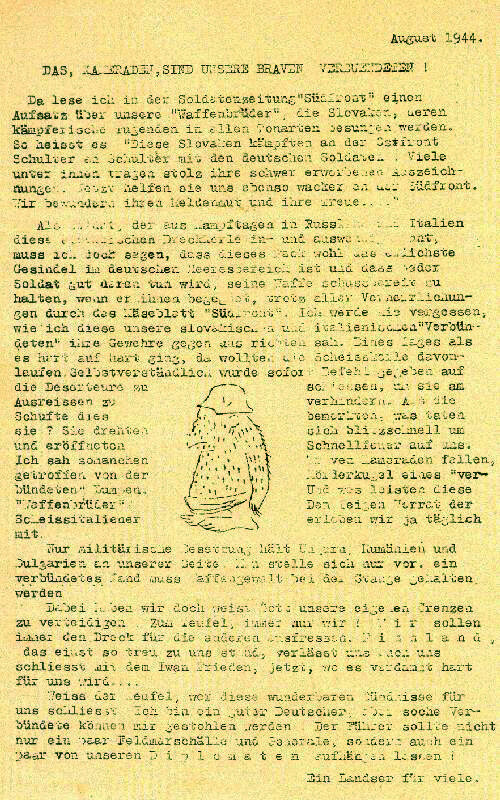
The "Worthy Allies" Lettersheet
The final letter is a designed to drive a wedge between the German Army and their many allies, including the various foreign legions that had joined in the war against Bolshevism. This is the only illustrated OSS letter. In the center of the leaflet is a little hairy ape that wears a loincloth and a steel helmet. The cartoon represents one of the "worthy allies" of Germany. The letter is written in a vulgar style pretending that it originates from a highly indignant and outraged German soldier. The text is, "August 1944. These, comrades, are our worthy allies! I am reading an article in the soldier’s newspaper ‘South Front’ about our ‘brothers in arms’ the Slovaks, and praises of their valor are being sung high and low. It says: ‘These Slovaks fought on the East Front shoulder to shoulder with German soldiers. Many of them wear with pride their hard-won decorations. Now they are helping us just as valiantly on the South Front. We admire their heroic courage and their faith.’ As a soldier who knows these foreign scum inside and out from days of battle in Russia and Italy, I have to say that, they are the most disgusting riffraff among the German army. Soldiers are well advised to keep his weapon ready to fire when he meets one of them, despite the entire glorification by the local rag "South Front." I shall never forget seeing our Slovak and Italian allies turn their weapons upon us. One day, in a tough fight, these bastards tried to run away. The order was given immediately to shoot the deserters to avoid their escape. What do you think they did? They turned around like lightning and opened rapid fire upon us. I saw many good comrades fall, hit by the murderous bullet of an ‘allied’ tramp. What have these "brothers in arms" achieved? Every day we watch the betrayal of the damned Italians. Only military occupation keeps Hungary, Rumania and Bulgaria on our side. Imagine, an allied country must be held by armed power. However, we have to defend our own frontiers. Damn it, why always us? It is always we who have to eat the dirt of others. Finland, once so true to us, has abandoned us and is making peace with Ivan now at a time when it is going to get hard for us. The devil knows who makes these wonderful alliances for us. I am a good German, but we can do without such allies. The Führer should not have just a few field marshals and generals hanged, but some of our diplomats too! One soldier speaking for many others."
This is just a very brief look at the lettersheets. Readers who wish to learn more about these lettersheets and see them illustrated and translated should read "Propaganda Ricocheted ‘Round Both Sides," Herbert A. Friedman, The American Philatelist," November, 1985.
Did Operation Cornflakes cause any damage to German morale? Probably not. From a strategic standpoint, the strain on the German postal system, including additional censoring might have caused some delays in mail delivery, creating morale problems. There might have been some belief among the more gullible that a functional anti-Nazi movement existed inside Germany. However, it seems clear that no long-range damage to the German war machine was accomplished.
Kermit Roosevelt says in The Overseas targets – War Reports of the OSS that:
By the end of the campaign the MO print shop had turned out some 30,000,000 items. An attempt was made to evaluate the effectiveness of “black” operations through investigations conducted among German prisoners of war…German troops had deserted in twenties and twenties…Italian Fascist troops deserted in blocks numbering up to 400, most of them carrying MO notes. The total of known deserters directly affected by MO subversion was estimated at 10,000.
It was however, impossible to evaluate the net over-all effects of black propaganda. Demoralization was cumulative, resulting not only from propaganda, but also from bombings, hardships, defeats and from countless other conditions and events.
The War Report – History of the OSS
Two volumes covering the history of the Office of Strategic Services (OSS) during World War II were produced in 1949 by the History Project, Strategic Services Unit, Office of the Assistant Secretary of War, War Department, Washington, D. C. The formal title of the report is War Report, Office of Strategic Services(OSS), it is also known as OSS War Report, Washington Organization, and Operations in the Field. These two volumes remained classified "Top Secret" for 53 years after they were completed. Volume 1 covers the organization of the OSS. Volume 2 covers OSS coordinated operations in the field. Looking through the report I see Cornflakes mentioned several times. One general comment is:
A device for the infiltration of "black" propaganda was the CORNFLAKES project, which exploited the disruption of the German postal system resulting from Allied bombing of the railways. Fake German mail bags were made and filled with copies of "Das Neue Deutschland" and subversive letters stamped, postmarked, and directed to real addresses taken from directories. These were dropped by the Fifteenth Air Force in strafing missions over marshalling yards and railroad stations, in the hope that they would be picked up as stray mail bags scattered from wrecked railroad cars and sent on through the regular mail. In twenty sorties, 320 mail bags were dropped.
Will we see espionage and propaganda stamps in the future? Probably not, according to CIA agents Torrey and Avery. In their secret report they conclude:
Forgery of postage stamps for intelligence purposes may be unnecessary in future operations. Postage meter marks have already largely replaced stamps for commercial mailing purposes in most countries of the world. The most widespread use of meters is for bulk mail and newspapers, printed matter, precisely the medium through which written propaganda is most easily disseminated. Meter marks eliminate the need for both stamp and cancellation forgeries, and reproduction of the simple red-inked double-purpose impression should be quite easy and effective. In any one country, meter impressions are to a high degree standardized in design, differing only in the letter and serial number of the machine. Unlike postage stamps, moreover, which are changed every few years, meters remain in use for long periods of time, the widespread distribution of all sizes of machines in post offices and business firms precluding frequent change. The American directors of Operation Cornflakes anticipated this development in including a meter mark--the only meter mark known to have been forged in wartime--in their mailbag mix.
The author would appreciate hearing from anyone who can shed more light on this subject. Readers with comments or questions are encouraged to write to him at sgmbert@hotmail.com.
